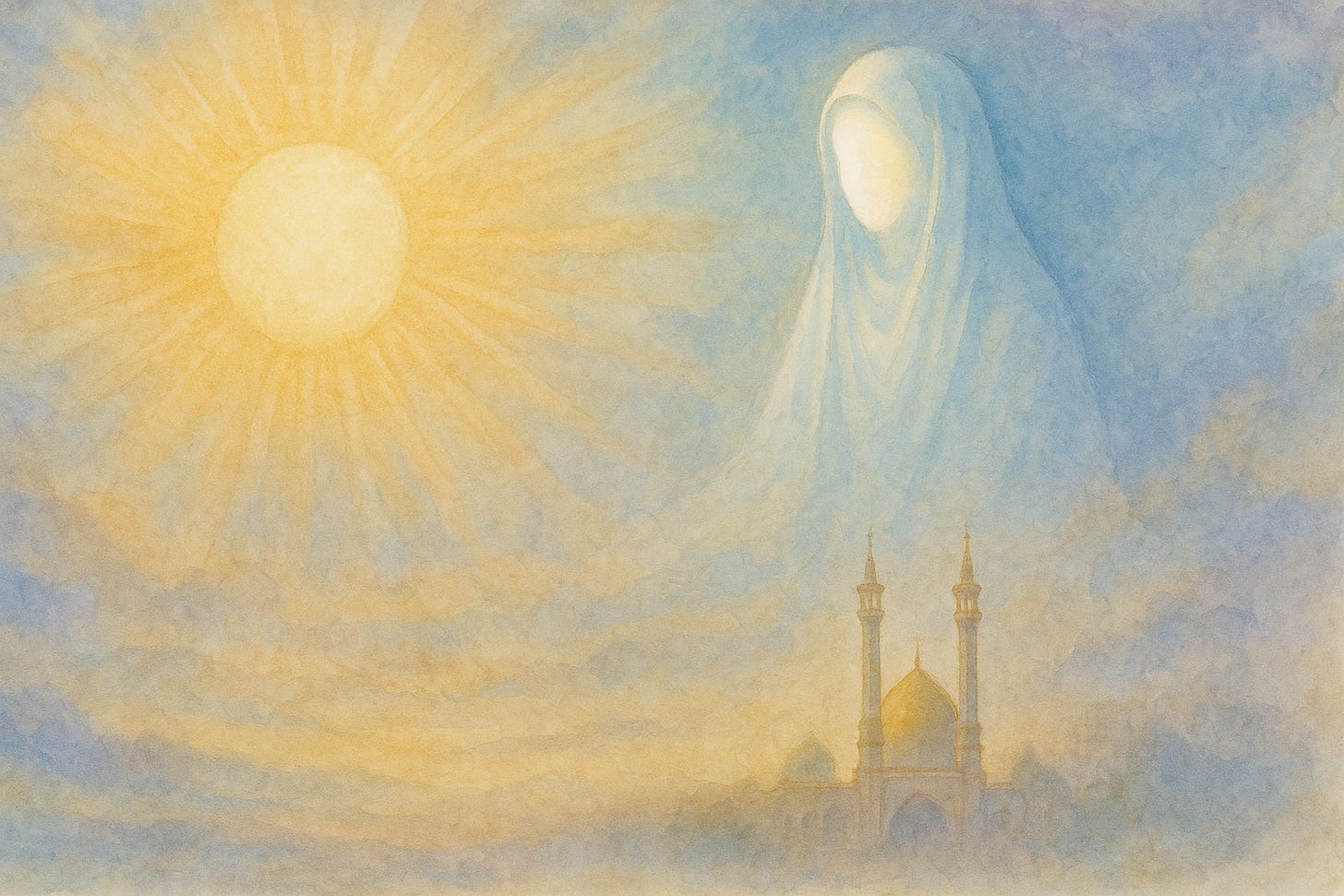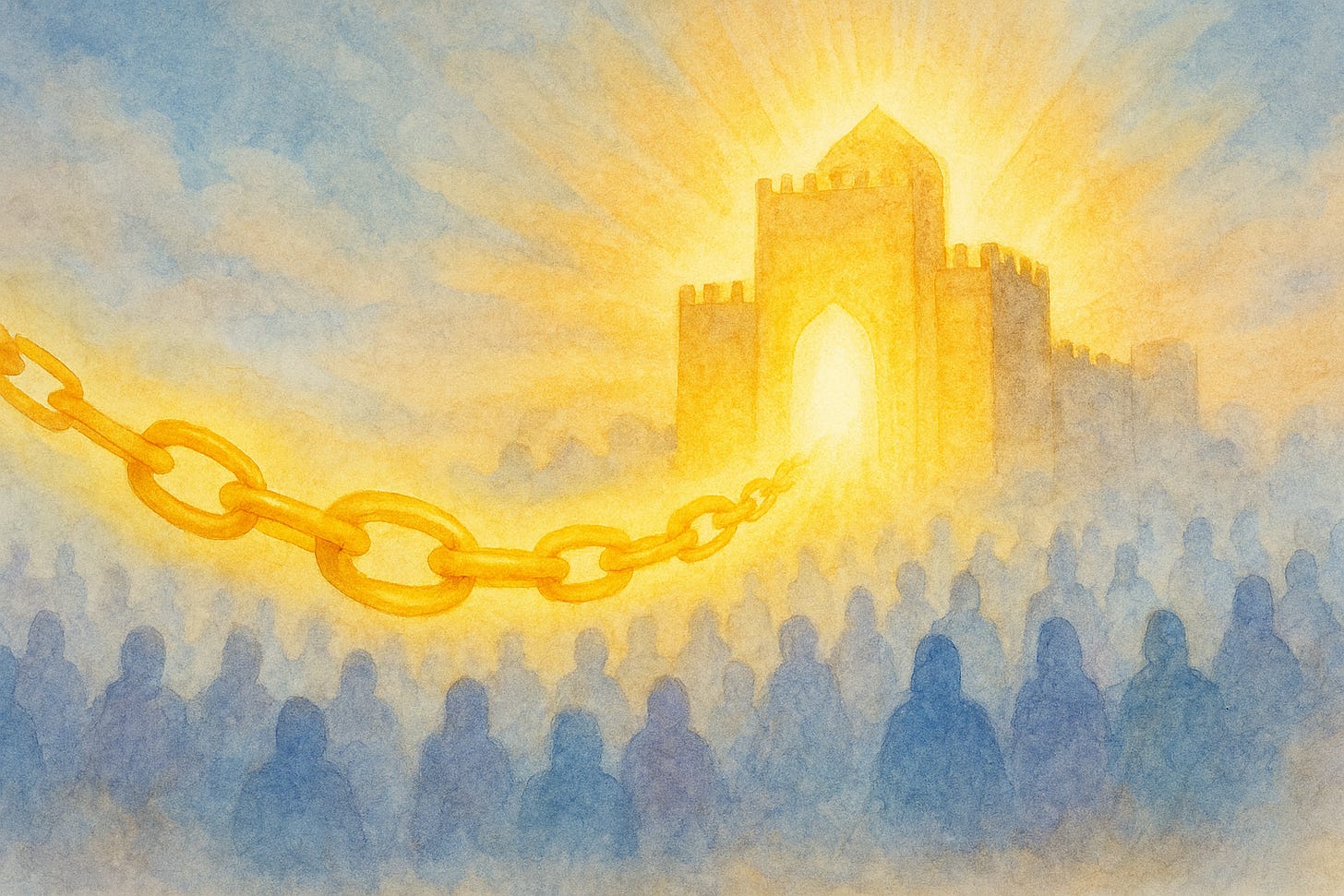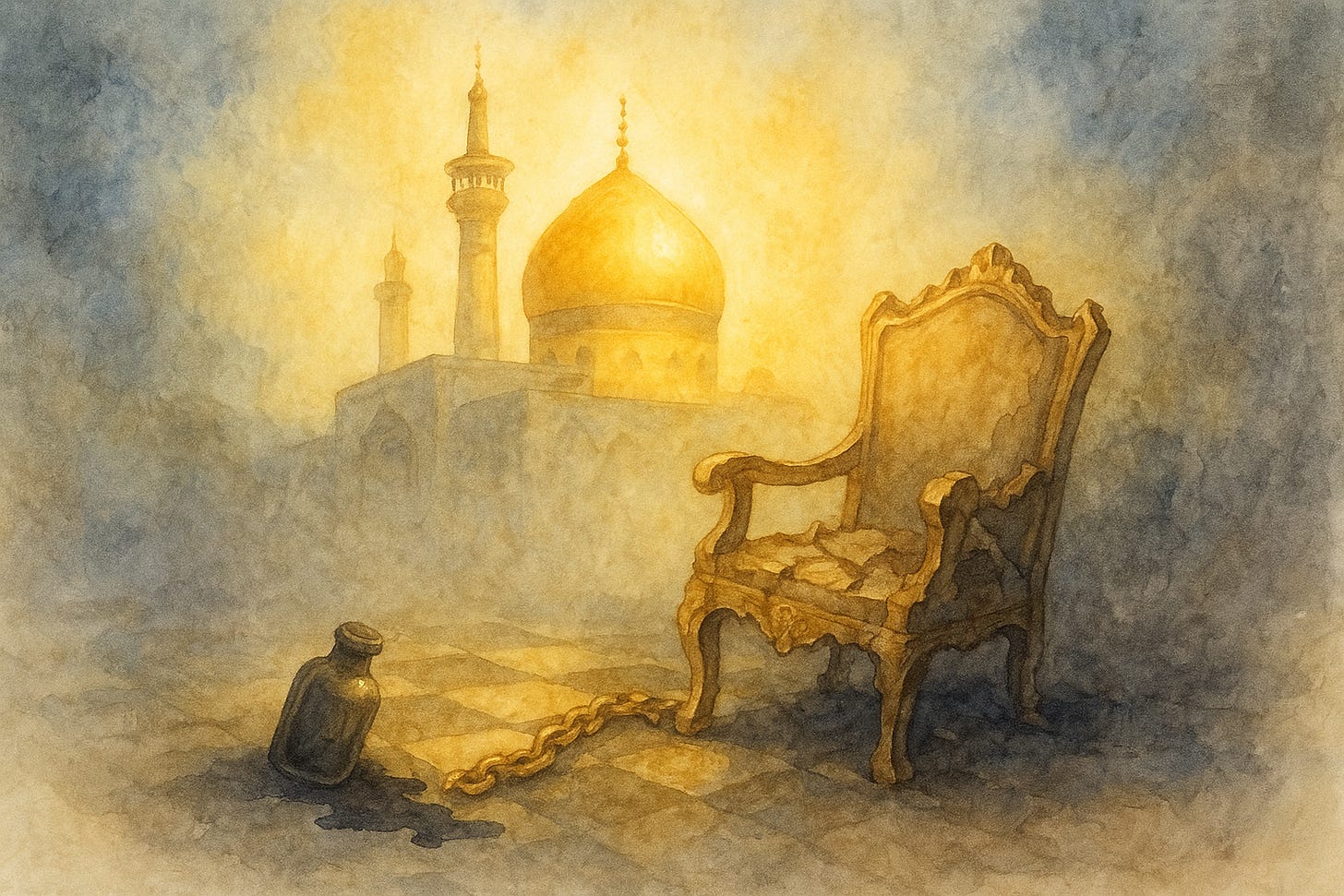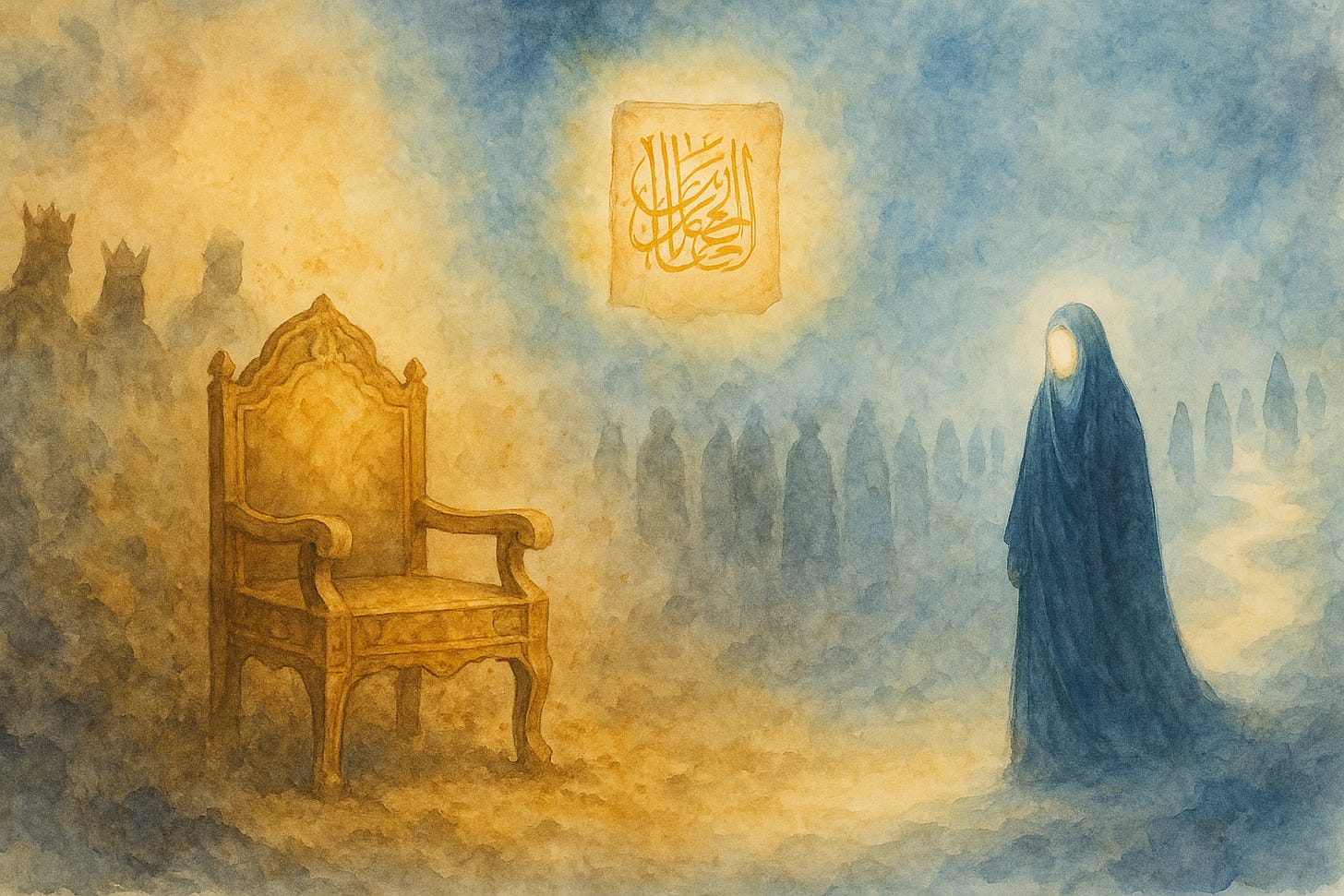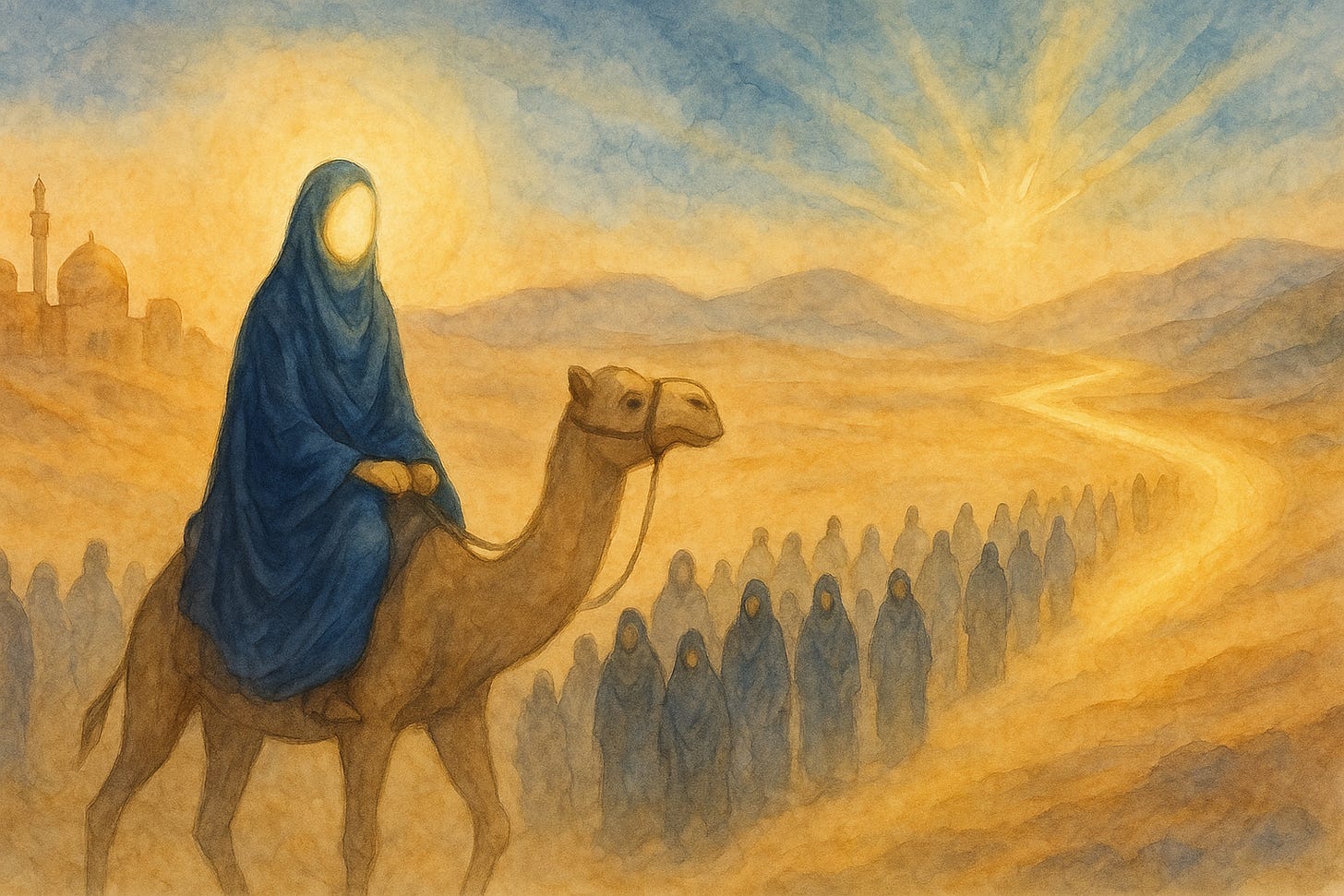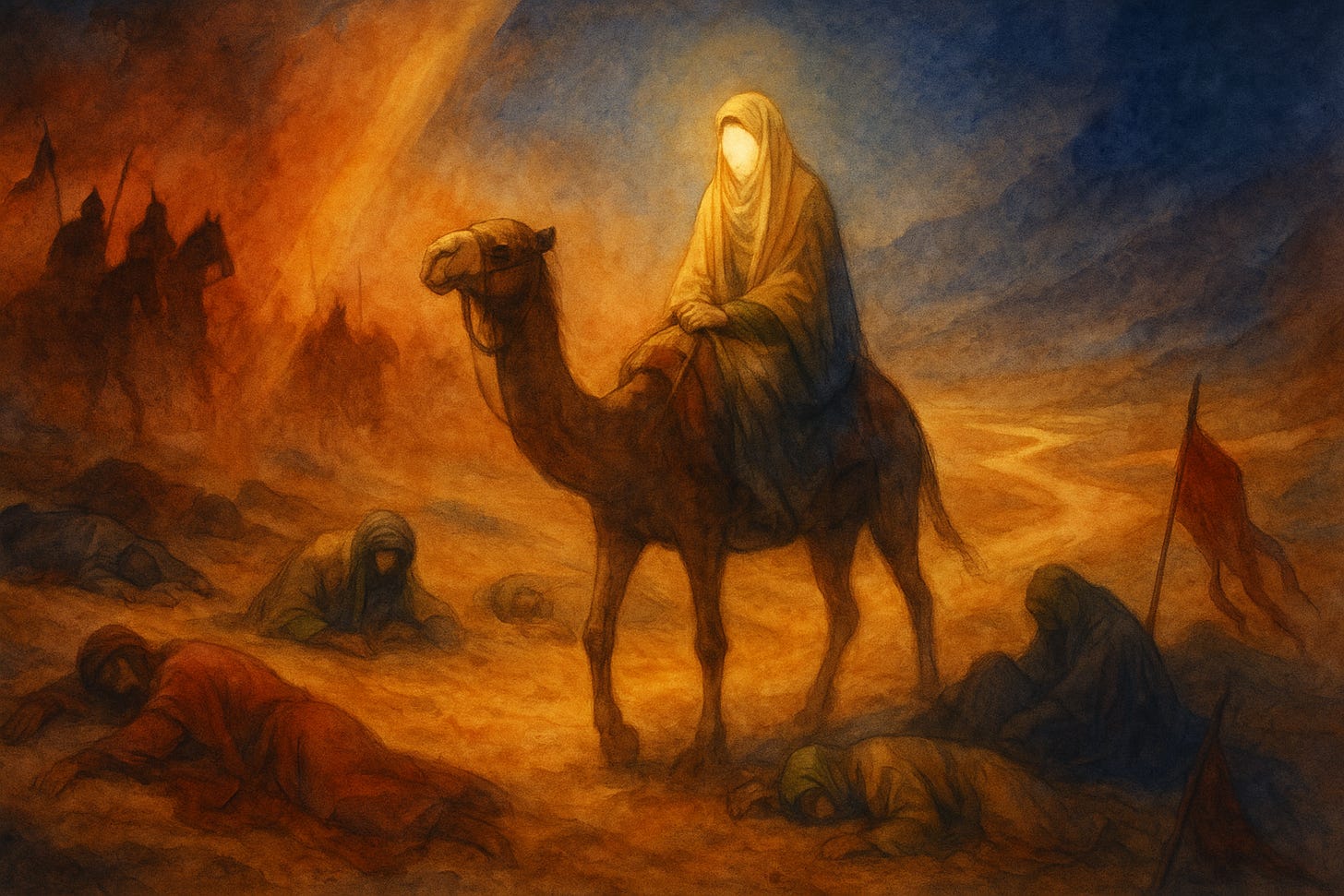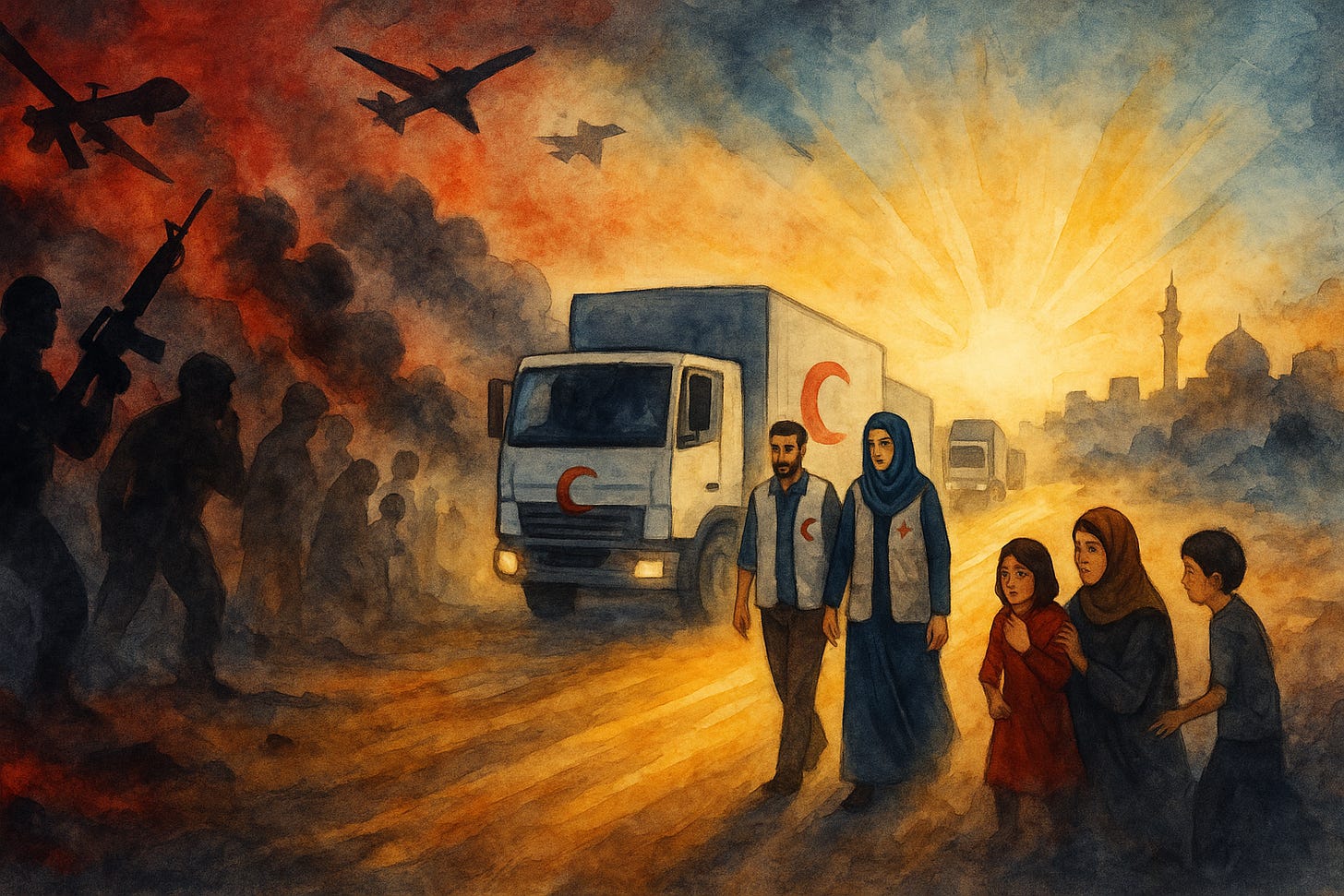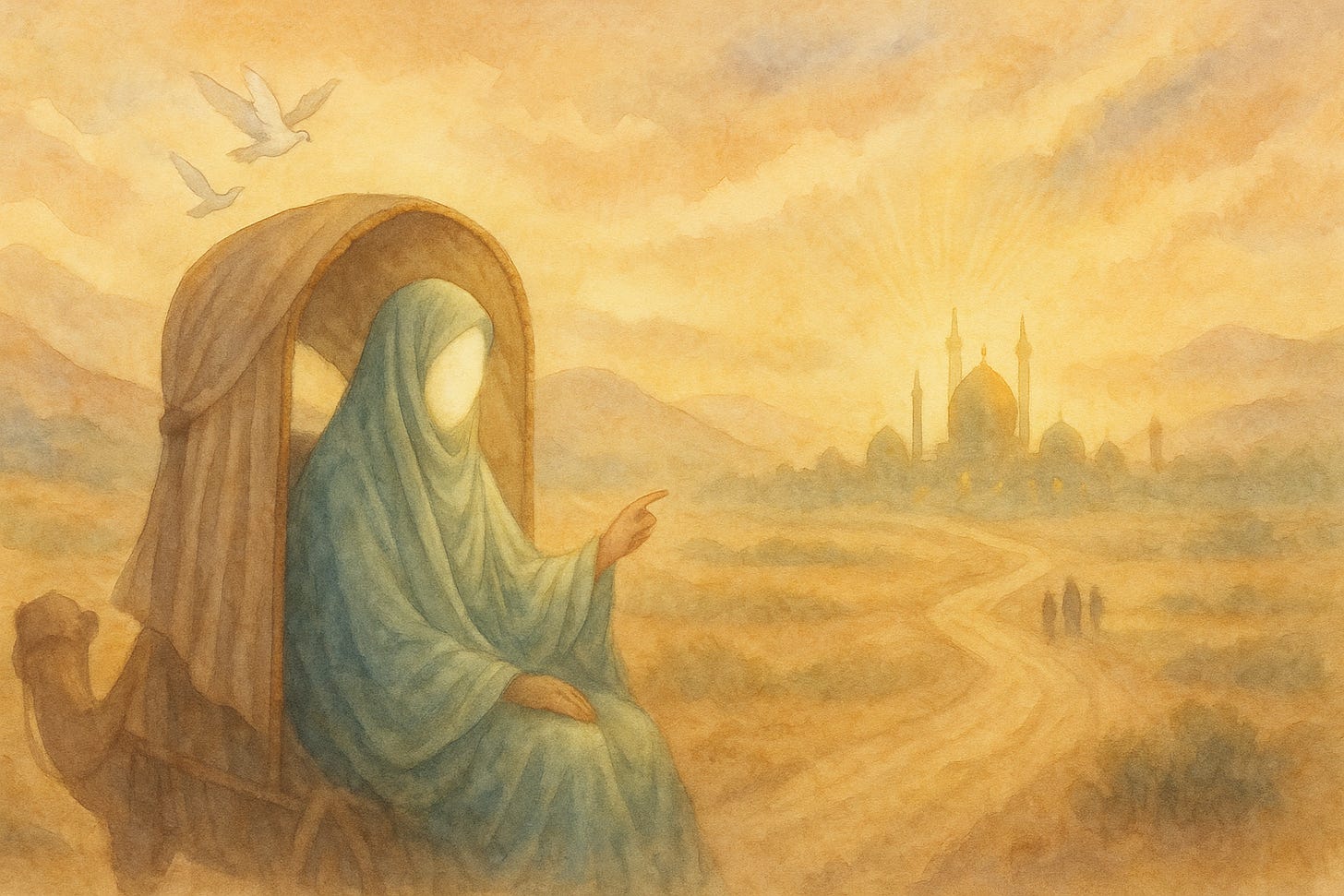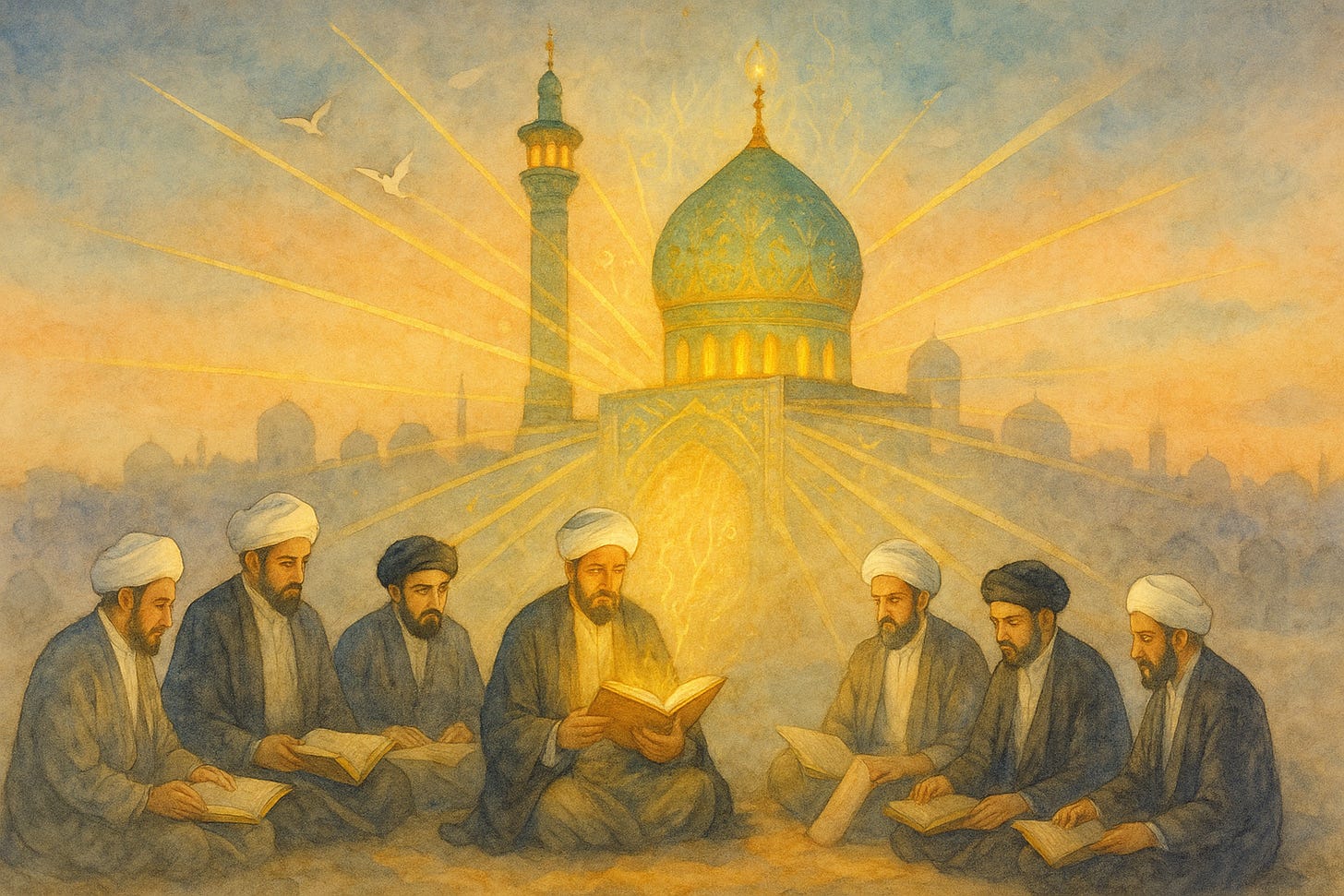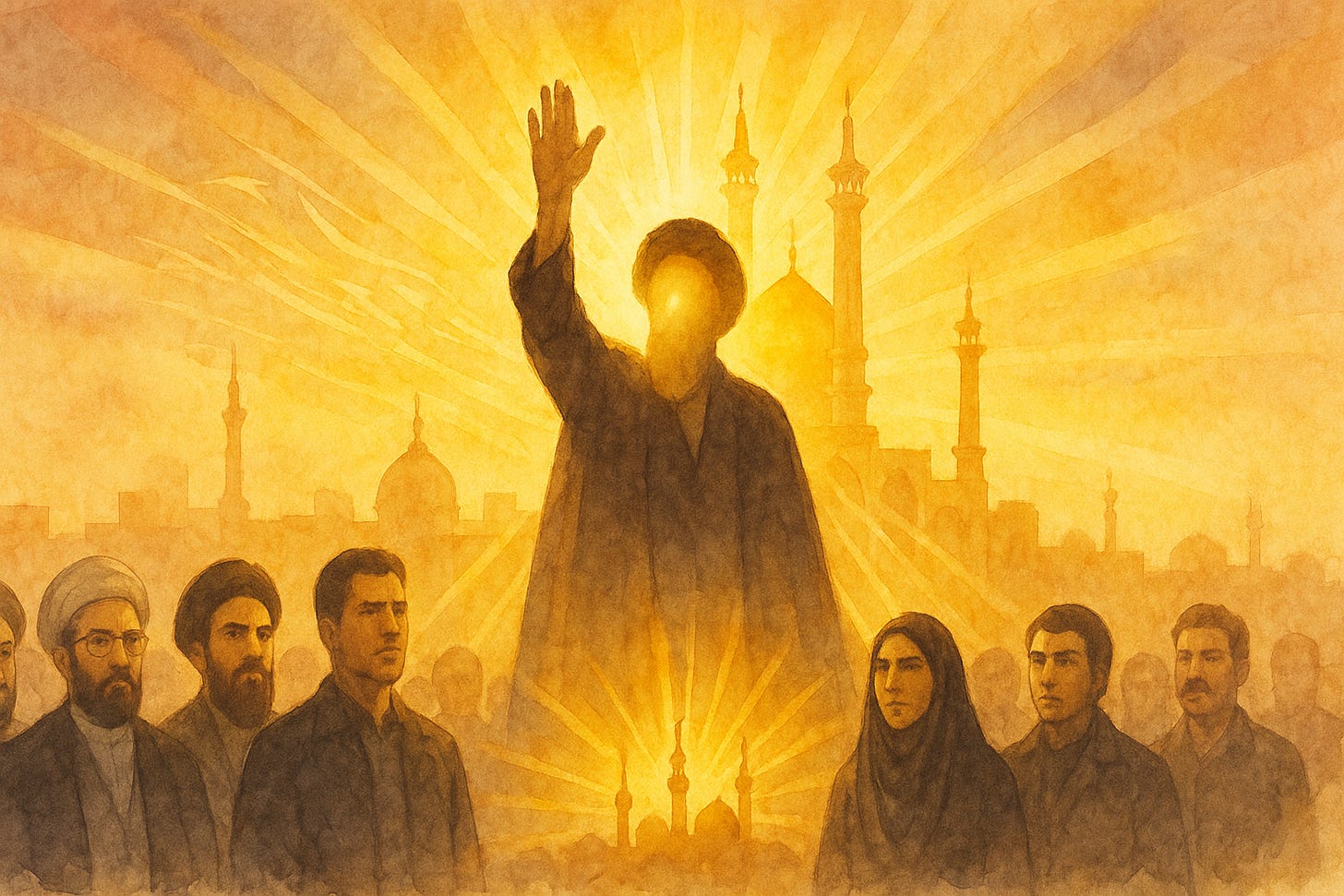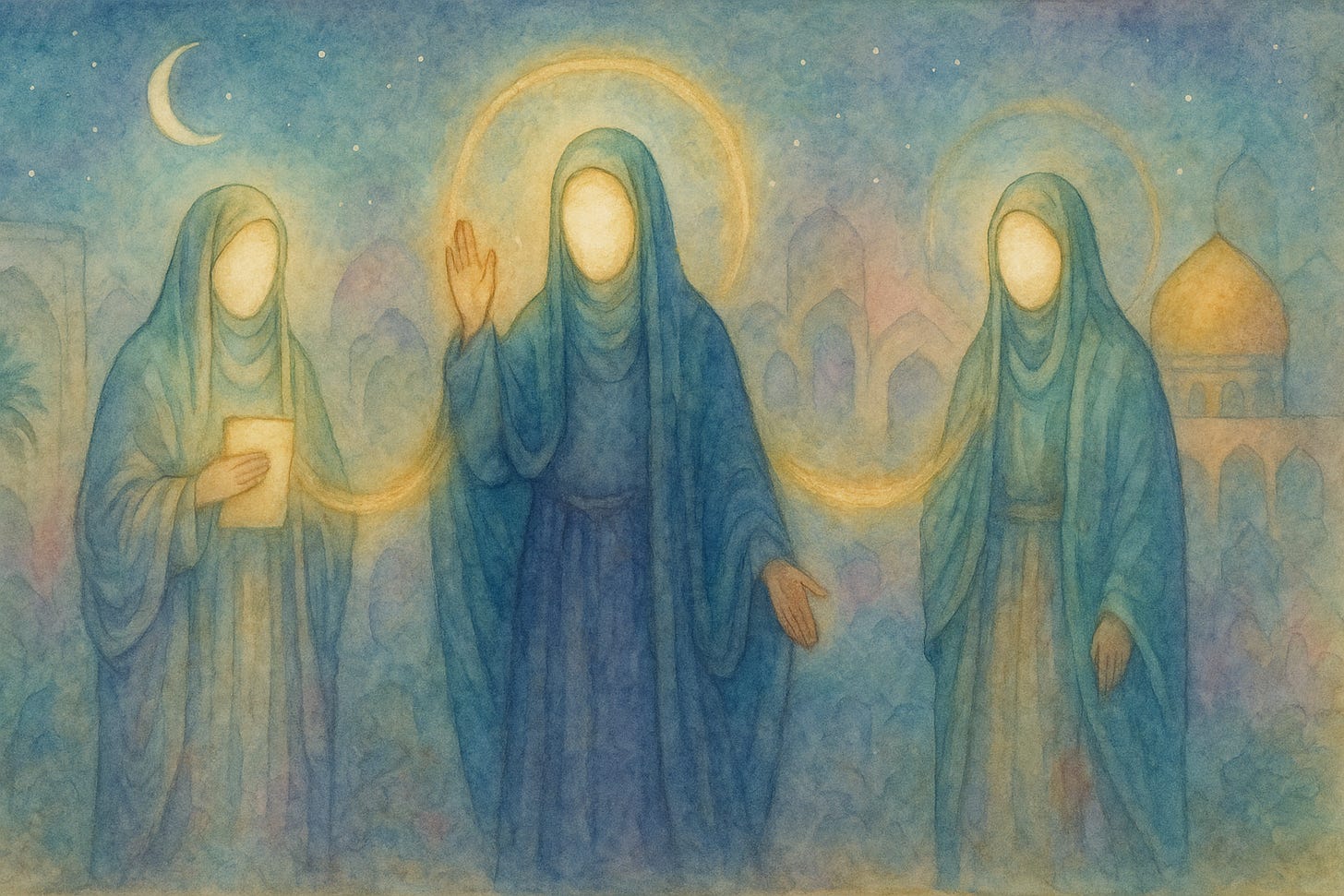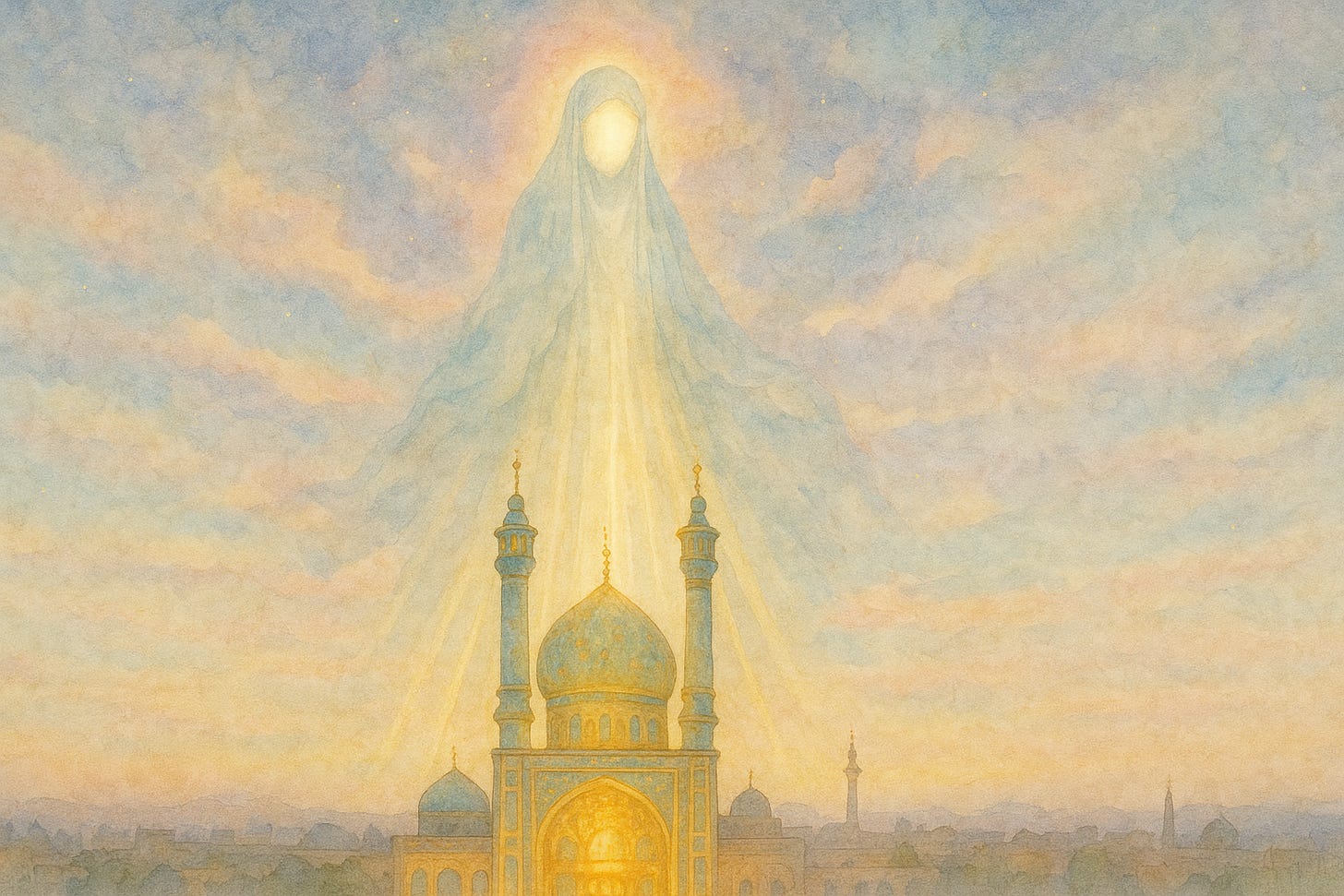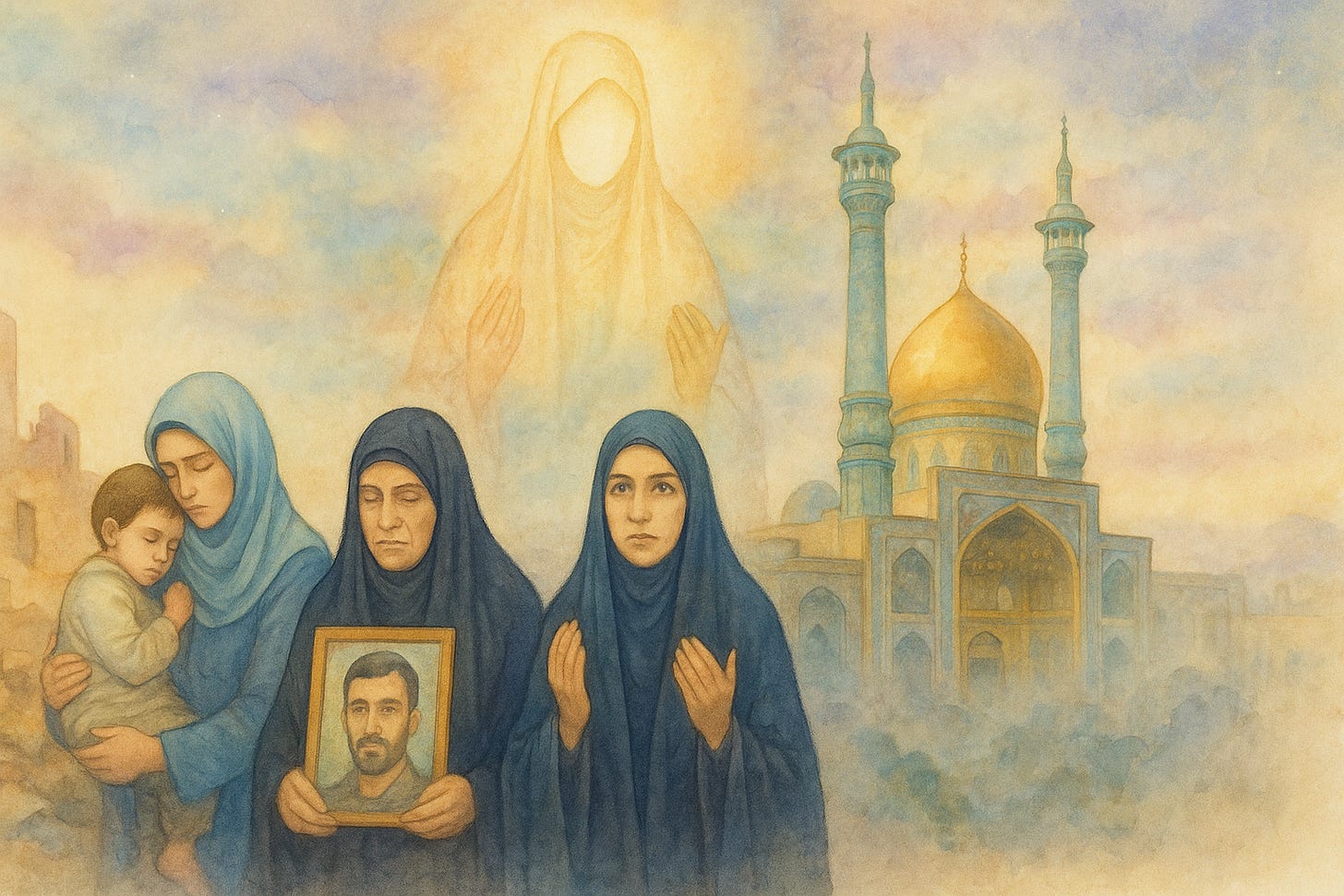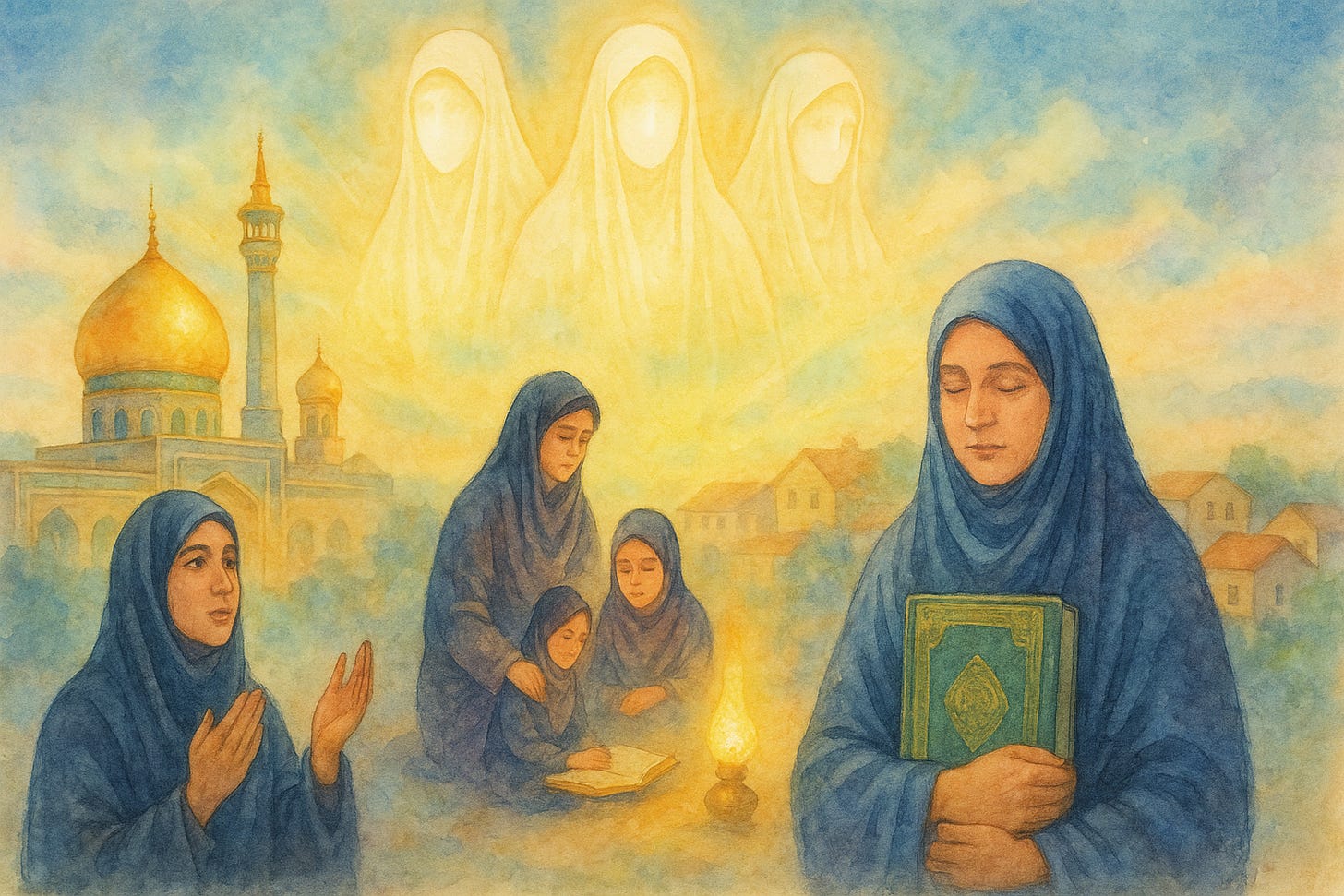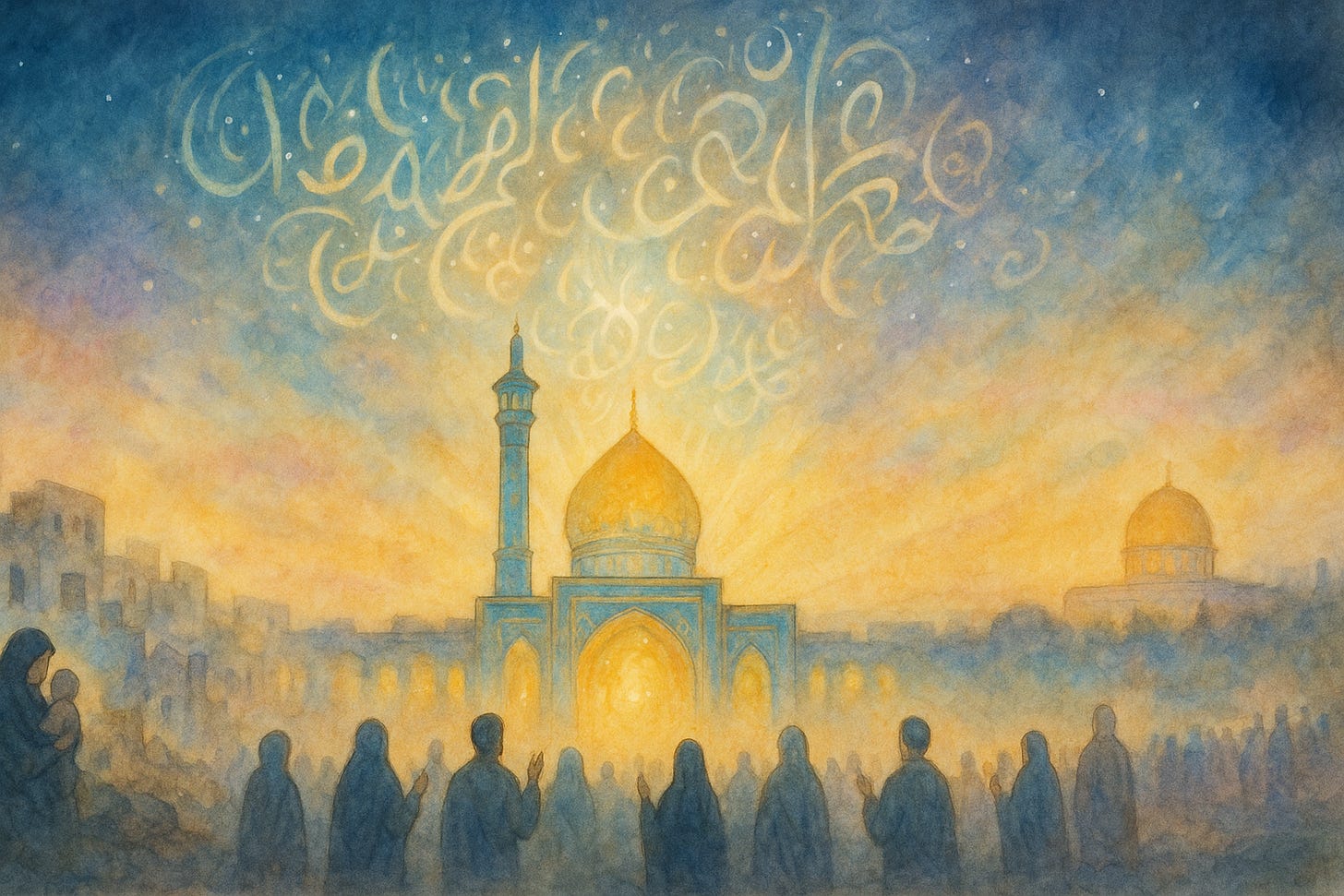[37] Imamah (Leadership) - Sayyedah Fatimah al-Ma’soumeh - Part 1: The Journey That Founded a City
A series of discussions on the teachings of Imam Sadiq (sixth Imam of the Muslims), from the book Misbah ash-Sharia (The Lantern of the Path)
In His Name, the Most High
This is part thirty-seven of our ongoing series of discussions on the book attributed to Imam al-Sadiq entitled Misbah ash-Sharia (The Lantern of the Path).
With this session, we introduce a new, vibrant thread, and as we begin to weave it into our study, we find ourselves guided by the echoes of our past discussions. The foundational principle of our study remains unchanged: each session builds upon the last, weaving together into a larger, interconnected tapestry.
Over the past four gatherings, we traced the profound trials and strategic triumphs of Imam Ali ibn Musa al-Ridha (peace be upon him), witnessing how divine leadership transforms traps into pulpits and persecution into victory.
That history is not merely a prelude; it is the very context in which our next reflection must be understood. For the light of the Imam is a sun, and that sun casts its rays upon the most noble of moons.
Today, we turn our hearts towards one such light: the sister of Imam al-Ridha, the noble lady of Qom, Sayyedah Fatimah al-Ma’soumeh (peace be upon her).
Her story is not separate from her brother’s; it is a powerful and poignant echo of it. It is a story of longing, of a journey undertaken out of unwavering loyalty to the Imam of the time. It is the story of a scholar whose knowledge reflected the divine wisdom of her house, and of a saint whose purity became a sanctuary for generations of believers.
Just as we dedicated several sessions to unpacking the depth of Imam al-Ridha’s mission, so too will we give this luminous story the space it deserves. Over the next two sessions, we will explore her life, her legacy, and her inseparable bond with the Imamate, understanding why her shrine in Qom became one of the great centres of Shia knowledge and spirituality. Her life is a testament that Wilayah is not only a station to be defended but a magnetic pole around which the purest hearts revolve.
With the epic of the Imam of Khorasan fresh in our minds, let us now turn to the story of the Lady of Qom.
In His most beautiful Name, and with full trust in His support, imploring His assistance and guidance, we proceed…
The previous parts can be found here:
Video of the Majlis (Sermon/Lecture)
This is the video presentation of this write-up as a Majlis (part of the Truth Promoters Weekly Wednesday Majlis Program)
Audio of the Majlis (Sermon/Lecture)
This is the video presentation of this write-up as a Majlis (part of the Truth Promoters Weekly Wednesday Majlis Program)
Recap
The Life and Legacy of Imam Ali ibn Musa al-Ridha
Over the past four sessions, we have traced the extraordinary life and mission of the eighth Imam, Ali ibn Musa al-Ridha (peace be upon him). We moved from the era of his noble father, Imam Musa al-Kadhim—an era defined by the overt violence of dungeons and chains—into the unique trial faced by Imam al-Ridha: not the brutality of the sword, but the subtle, political poison of a throne.
This four-part journey revealed a masterclass in divine leadership, showing how the Imam navigated and ultimately defeated one of the most sophisticated plots ever conceived to extinguish the light of the Ahl al-Bayt.
The Chessboard and the Gilded Cage
Our exploration began with the Abbasid caliph Ma’mun, who, having learned that martyrdom only strengthens Shi’ism, devised a new strategy. Instead of persecuting the Imam, he sought to co-opt him by appointing him as his heir-apparent. This was a “gilded cage,” designed to achieve several goals: to neutralize the revolutionary spirit of the Imamate, to legitimize the corrupt Abbasid regime, to control the Imam directly, and to sever him from his followers.
Imam al-Ridha (peace be upon him) immediately exposed this trap. He framed his forced journey from Madinah not as an honour but as a march towards martyrdom. Upon his arrival in Marv, he initially refused the succession. Only under the direct threat of death did he accept, and even then, he imposed debilitating conditions: he would not appoint, dismiss, judge, or involve himself in any affair of the state. He accepted an empty title but refused all authority, turning Ma’mun’s intended victory into a public humiliation for the caliphate.
From Containment to Amplification
Ma’mun’s strategy of containment backfired spectacularly. The Imam transformed his forced journey into a travelling pulpit, using every stop to engage with the people and clarify the truths of Imamate.
This reached its zenith in Nishapur with the narration of the famous Hadith of the Golden Chain. After declaring that belief in God’s Oneness (La ilaha illa Allah) is a fortress of salvation, the Imam added the momentous condition: “...and I am one of its conditions.”
With these words, he publicly and inseparably linked Tawhid (monotheism) with Wilayah (divinely-mandated guardianship), cementing the core of the Shia creed for all time.
In Ma’mun’s own court, through masterful debates and the patronage of poets, the Imam further amplified this message, turning a plan for his containment into the loudest public proclamation of Shi’ism in decades.
A Victory in Refusal
Ma’mun’s grand scheme ultimately collapsed under the weight of the Imam’s steadfastness. By refusing to participate in or legitimise the state, the Imam shattered the illusion of a partnership. His mere presence acted as an unflattering mirror, exposing the deep corruption and hypocrisy of the Abbasid court and causing Ma’mun’s pious facade to crumble.
Having failed at co-option and containment, a defeated Ma’mun resorted to the crude weapon of his predecessors: poison. The Imam’s martyrdom was not a defeat, but rather Ma’mun’s final, desperate admission that his entire political project had failed. This act immortalised the Imam, and his radiant shrine in Mashhad stands today as an eternal testament to the truth that thrones of tyrants rot, while the light of the oppressed endures.
Imamate Beyond Thrones
Finally, we reflected on the enduring legacy of the Imam’s stance. His life affirmed the essential truth that Imamate is not a political office to be granted by kings, but a divine covenant established by God’s command (nass). It is a sacred trust, not a worldly prize.
From his principled stand, we derived critical jurisprudential lessons on the absolute prohibition of voluntarily cooperating with oppressive systems and the crucial balance between strategic concealment (taqiyyah) and public clarification (tabyeen).
His trial also taught us a painful internal lesson: the danger of fitnah (sedition) from followers who, lacking insight (basirah), mistake their own limited judgment for piety and fracture the community from within.
The Imam’s life is a timeless call for unity, humility, and unwavering loyalty to the rightful, divinely-appointed leadership.
This legacy of divine authority, strategic clarity, and profound sacrifice is the very world into which his noble sister, Sayyedah Fatimah al-Ma’soumeh (peace be upon her), was born and from which her own story of light and loyalty unfolds.
Imamah (Leadership) – Sayyedah Fatimah al-Ma’soumeh: The Journey That Founded a City
Her Lineage and Journey of Loyalty
To understand the station of Sayyedah Fatimah al-Ma’soumeh, one must first situate her within the context of her origin. Her identity is inseparable from the house of her father, Imam Musa al-Kadhim—a house that served as a fortress of divine knowledge in an era defined by the darkness of Abbasid prisons.
The House of Wilayah: Born Into the Chain of Imamate
Sayyedah Fatimah al-Ma’soumeh (peace be upon her) was born into the very epicentre of the Imamate. She was the daughter of the seventh Imam, Musa ibn Ja’far al-Kadhim, and the sister of the eighth Imam, Ali ibn Musa al-Ridha.
Her upbringing was not merely in the presence of Imams, but in the living embodiment of the Imamate itself.
This was a household where persecution from the state was met with patience (sabr) from the Imam, and where attempts to extinguish the light of guidance only intensified its radiance within the home. She was thus nurtured by the twin realities of divine proximity and worldly trial.
This inheritance is a cornerstone of Shia theology. The leadership of the Ahl al-Bayt is not a matter of political accident or tribal succession; it is a divinely ordained continuation of prophetic guidance. The Qur’an identifies the essential qualities of these chosen leaders:
وَجَعَلْنَاهُمْ أَئِمَّةً يَهْدُونَ بِأَمْرِنَا وَأَوْحَيْنَا إِلَيْهِمْ فِعْلَ الْخَيْرَاتِ وَإِقَامَ الصَّلَاةِ وَإِيتَاءَ الزَّكَاةِ ۖ وَكَانُوا لَنَا عَابِدِينَ
“And We made them leaders (Imams), guiding by Our command. And We inspired to them the doing of good deeds, the establishment of prayer, and the giving of zakat; and they were worshippers of Us.”
— Qur’an, Surah al-Anbiya (the Chapter of the Prophets) #21, Verse 73
The key to understanding the divine station of the Imam lies in the phrase “guiding by Our command”.
In his monumental exegesis, Tafsir al-Mizan, Allamah Sayyed Muhammad Husayn Tabataba’i (may God rest his pure soul) provides a profound analysis of this term.
He explains that the “command” mentioned here is not the legislative command (al-amr al-tashri’i)—that is, the laws of the Shari’ah revealed to the prophets. That form of guidance, which involves showing the path, is the duty of every prophet. The guidance of the Imam described in this verse is of a higher, more exclusive nature.
It refers to God’s creative and existential command (al-amr al-takwini), the very power that brings reality into being.
Allamah Tabataba’i writes:
فالمراد بالأمر أمر الهداية الذي يهدي به الله من يشاء من عباده، وهو غير السبيل الذي يهدي إليه أمر الدعوة، فإن ذلك شأن الأنبياء والرسل ومن دونهم من المؤمنين جميعا. وهذا الأمر هو الذي يصاحب الإمام ويهدي به، وهو أمر ملكوتي يصاحب الأشياء فيوجدها ويدبرها.
“Thus, what is meant by ‘the command’ is the command of guidance by which God guides whomsoever He wills from among His servants.
This is different from the path to which the call of da‘wah guides, for that is the affair of the prophets, the messengers, and the believers below them.
This [higher] command is what accompanies the Imam and by which he guides, and it is a command of the spiritual dominion (amr malakuti) which accompanies things, bringing them into existence and directing them.”
— Allamah Tabataba’i, Tafsir al-Mizan, Volume 14, Commentary on Surah al-Anbiya Verse 73, Page 306
The implication of this is profound.
The Imam does not merely point out the correct path; through his connection to this amr malakuti, he possesses a form of spiritual guardianship (wilayah takwiniyyah) that allows him to inwardly guide the hearts of sincere believers, nurturing them and escorting them towards their spiritual destination.
This is a metaphysical reality, a divine station rooted in God’s absolute will, completely beyond the authority of earthly kings to confer or manipulate.
Sayyedah Ma’soumeh was therefore a direct inheritor of this divinely-sourced truth. She was a reflection of the purity spoken of by her ancestor, Imam Ja’far al-Sadiq, when he described the nature of their household:
إِنَّ اللهَ طَهَّرَ قُلُوبَنَا وَأَجْرَى فِيهَا يَنَابِيعَ الْحِكْمَةِ، وَجَعَلَنَا خُزَّانَ عِلْمِهِ
“Indeed, God has purified our hearts and caused the springs of wisdom to flow within them, and He has made us the treasurers of His knowledge.”
— Al-Kulayni, Al-Kafi, Volume 1, Kitab al-Hujjah (The Book of the Proofs), Chapter on the Imams being the Treasurers of God’s Knowledge, Page 224, Hadeeth 2
This was the environment that produced her: a house of purification, wisdom, and divine trust.
Her Journey of Loyalty: The Hijrah Towards Her Imam
When Imam al-Ridha was forcibly taken from Madinah to Khurasan in the year 200 AH, the Abbasid caliph al-Ma’mun intended to isolate the Imam from his base of support.
In 201 AH, Sayyedah Ma’soumeh initiated a profound counter-move. Her departure from Madinah at the head of a caravan was not simply a journey of familial longing; it was a Hijrah—a conscious and deliberate migration in loyalty to the Imam of her time.
In Islamic thought, a Hijrah signifies a movement away from a state of compromise or danger towards one of faith and security.
For Sayyedah Ma’soumeh, the security of the entire faith rested with the Imam. To be severed from him was the ultimate danger; to move towards him was the ultimate act of submission.
Her journey was a physical manifestation of the principle articulated by Imam Ali ibn Abi Talib:
إِنَّمَا هُوَ الْإِسْلَامُ، وَالْإِسْلَامُ هُوَ التَّسْلِيمُ
“Indeed it is Islam, and Islam is submission (al-taslim).”
— Al-Sharif al-Radhi, Nahj al-Balagha, Volume 4, Section on Aphorisms and Short Sayings (Hikam), Saying #125, Page 30
By leaving the city of her ancestors, she declared that the true homeland of a believer is not a piece of land, but proximity to the Proof of God. Her action was a political statement against the legitimacy of the Abbasid state and a spiritual statement on the centrality of the Imam.
Sacrifice on the Road: Echoes of Karbala
The path of principled defiance inevitably intersects with the forces of tyranny. As her caravan approached the city of Saveh, it was ambushed by Abbasid agents. In the ensuing violence, several members of her family were martyred.
Historical accounts state that the noble lady herself was poisoned, falling gravely ill. This attack transformed her journey of loyalty into a journey of sacrifice, creating a powerful parallel with the ordeal of her great-aunt, Sayyedah Zaynab, following the massacre at Karbala.
Both noble ladies undertook perilous journeys as a testament to their loyalty to the Imam of their age. Both refused to be intimidated into silence.
Sayyedah Ma’soumeh’s journey was an active rejection of the Abbasid political order, a practical embodiment of the jurisprudential prohibition against collaborating with unjust powers.
That principle, a pillar of Shia political fiqh (jurisprudence), remains unchanged. It is not merely a recommendation but a foundational command rooted in the very text of the Qur’an and the traditions of the Ahl al-Bayt.
The Qur’an issues a stark and unequivocal warning against even the slightest inclination towards oppressors:
وَلَا تَرْكَنُوا إِلَى الَّذِينَ ظَلَمُوا فَتَمَسَّكُمُ النَّارُ وَمَا لَكُم مِّن دُونِ اللَّهِ مِنْ أَوْلِيَاءَ ثُمَّ لَا تُنصَرُونَ
“And do not incline toward those who do wrong, lest the Fire should touch you, and you have not besides God any protectors; then you would not be helped.”
— Qur’an, Surah Hud (the Chapter of (Prophet) Hud) #11, Verse 113
The Arabic verb used here, tarkanu, is incredibly precise. It does not mean to actively join or fight alongside them. It means to incline towards, to lean on, to feel a sense of security with, or to approve of them.
This prohibition targets the very seed of complicity. The fire touches not only the active collaborator but also the one whose heart inclines towards the oppressor.
The Imams of the Ahl al-Bayt built upon this Qur’anic foundation with uncompromising clarity. In a famous and searing tradition, Imam Musa al-Kadhim—the father of Sayyedah Ma’soumeh—confronted one of his own companions, Safwan al-Jammal, who used to rent his camels to the Abbasid caliph Harun al-Rashid.
Safwan tried to justify his actions, but the Imam dismantled his reasoning, concluding with a question that pierces the conscience:
يَا صَفْوَانُ، أَتُحِبُّ بَقَاءَهُمْ حَتَّى يَخْرُجَ كِرَاؤُكَ؟ قَالَ: نَعَمْ. قَالَ: فَمَنْ أَحَبَّ بَقَاءَهُمْ فَهُوَ مِنْهُمْ، وَمَنْ كَانَ مِنْهُمْ كَانَ وَرَدَ النَّارَ
“O Safwan, do you love for them to remain (in power) until your payment comes back to you?” He replied, “Yes.” The Imam said: “Whoever loves for them to remain is one of them, and whoever is one of them will enter the Fire.”
— Al-Kulayni, Al-Kafi, Volume 5, Kitab al-Ma’ishah (The Book of Livelihood), Bab Amal al-Sultan wa Ja’izatihi (Chapter on Working for the Ruler and His Gifts), Page 107, Hadeeth 5
This defines the vast scope of forbidden cooperation. It is not limited to holding a sword in the tyrant’s army. It includes any action, economic or social, that contributes to the stability and continuation of an oppressive system. To wish for the tyrant’s survival, even for a day, just to secure one’s own income, is to become one of them.
This principle is the bedrock of the political ethics of the school of Resistance. The martyred leader of Hizbullah, Sayyed Abbas al-Mousawi, understood that proximity to power is a constant test of one’s integrity.
He drew his lesson directly from the life of Imam al-Ridha, stating:
إِنَّ الْإِمَامَ الرِّضَا عَلَّمَنَا أَنْ نَكُونَ فِي الْقَصُورِ بِلَا أَنْ نَكُونَ مِنْ أَهْلِ الْقُصُورِ
“Imam al-Ridha (peace be upon him) taught us how to be within the palaces without ever becoming of the people of the palaces.”
— Sayyed Abbas al-Mousawi, from his collected speeches in the volume Khitabat wa Kalimat al-Shahid al-Sayyed Abbas al-Mousawi, Page 112
The danger is assimilation—to adopt the logic, the priorities, and the silence of the oppressor. This is why silence in the face of systemic injustice is not neutrality; it is a form of inclination, a type of rukoon.
The Shaykh of the Martyrs of the Resistance, Shaykh Ragheb Harb, whose blood sanctified the struggle in South Lebanon, famously declared his position with the words:
إن لم تستطيعوا أن تغيروا الواقع، فلتعلنوا موقفكم منه. الموقف سلاح، والمصافحة اعتراف
“If you are unable to change the reality, then you must declare your stance on it. The stance is a weapon, and the handshake is a recognition [of the enemy’s legitimacy].”
— Shaykh Ragheb Harb, Public Declaration and Defining Slogan, in his capacity as the Friday Prayer Imam, Jibsheet, South Lebanon, circa 1983
A stance—clear, unwavering, and public—is itself an act of war against injustice.
Therefore, when we witness the industrial-scale slaughter and calculated starvation of the people of Gaza, silence is complicity. Token gestures, such as abstract calls for peace that equate the victim with the executioner, or political manoeuvres like “recognising a Palestinian state” while continuing to arm and fund the Zionist entity, are worse than silence. They are a facade designed to manage public opinion while allowing the genocide to continue.
They are a modern form of lending camels to Harun al-Rashid.
True opposition, true loyalty to the principles of the Imamate, demands an active and unambiguous stance of resistance.
As the martyred Secretary General of Hizbullah, Sayyed Hassan Nasrallah, has repeatedly clarified, the goal of the enemy is to make their crimes seem normal, to make their existence in the region a settled fact.
إن أخطر ما نواجهه في هذه المرحلة هو محاولة البعض للدفع باتجاه الاعتياد على مشاهد القتل والدمار، والتعايش مع الظلم كأمر واقع. هذا هو الموت الحقيقي للأمة. واجبنا هو أن نبقي هذه القضية حية في الوجدان وفي الميدان
“The most dangerous thing we face at this stage is the attempt by some to push towards becoming accustomed to the scenes of killing and destruction, and to co-exist with oppression as a de facto reality. This is the true death of the Ummah. Our duty is to keep this cause alive in the conscience and on the battlefield.”
— Sayyed Hassan Nasrallah, from a televised speech on Al-Manar, addressing the ongoing conflict and the duty of the Ummah, Beirut, Lebanon, November 3, 2023
This is why the juristic ruling articulated by our highest authorities on this matter is so absolute. It is not the opinion of one scholar but an unbroken chain of consensus, a principle defended with remarkable unanimity across the great seminaries of our time.
This principle finds its modern jurisprudential roots in the work of the teacher of the jurists, Ayatollah al-Udhma Sayyed Abu al-Qasim al-Khu’i, who laid the foundation in his legal treatise:
لا تجوز إعانة الظالمين على ظلمهم، بل ولا مطلق التعاون معهم المحسوب من أعوانهم، إلا لضرورة وبقدرها.
“It is not permissible to aid the oppressors in their oppression, nor any form of cooperation with them that would cause one to be counted among their helpers, except in a case of necessity (dharurah) and only to the extent of that necessity.”
— Ayatullah al-Udhma Sayyed Abu al-Qasim al-Khu’i, Minhaj al-Salihin, Volume 2, Kitab al-Makasib (Book of Transactions), Mas’ala (Issue) #20, Page 9
Building upon this bedrock, the great authorities in Najaf today speak with a single voice.
Ayatollah al-Udhma Sayyed Ali al-Sistani affirms this with the words:
لا يجوز إعانة الظالمين في ظلمهم، بل ومطلق التعاون معهم، إلّا مع الضرورة، وبمقدار ما تقتضيه
“It is not permissible to aid the oppressors in their oppression; indeed, any form of cooperation with them is prohibited—except in a state of necessity, and then only to the extent that necessity requires.”
— Ayatullah al-Udhma Sayyed Ali al-Sistani, Minhaj al-Salihin (The Path of the Righteous), Volume 1, Chapter on Prohibited Transactions, Issue #29, Page 13
This consensus is echoed by his contemporaries.
Ayatollah al-Udhma Shaykh Ishaq al-Fayadh states the prohibition covers anything that strengthens the oppressor:
لا تجوز إعانة الظالمين في ظلمهم، بل ولا في كل ما يرجع إلى شوكتهم وقدرتهم، إلا إذا كانت هناك ضرورة ملحة.
“It is not permissible to aid the oppressors in their oppression, nor in anything that contributes to their power (shawkah) and ability, except where there is a pressing necessity.”
— Ayatullah al-Udhma Shaykh Ishaq al-Fayadh, Minhaj al-Salihin, Volume 2, Kitab al-Makasib al-Muharramah (Book of Prohibited Transactions), Mas’ala (Issue) #29
And Ayatollah al-Udhma Shaykh Bashir al-Najafi adds a crucial dimension, noting that cooperation is forbidden even in neutral matters if it harms the faith or the faithful:
لا تجوز إعانة الظالمين في ظلمهم على المظلومين... والتعاون معهم في غير الظلم، إن عدّ وهناً على الدين أو ترويجاً للباطل أو وهناً على المؤمنين فلا يجوز أيضاً.
“It is not permissible to aid the oppressors in their oppression against the oppressed... As for cooperating with them in matters other than oppression, if it is considered a weakening of the religion, a promotion of falsehood, or a weakening of the believers, then it is also not permissible.”
— Ayatullah al-Udhma Shaykh Bashir al-Najafi, from his official collection of fatawa on his website, Section on Amr bi’l-Ma’ruf wa Nahy an al-Munkar.
Moving from the seminary to the state, this principle is applied with equal force to the act of holding office within an unjust system.
The late Ayatollah al-Udhma Sayyed Muhammad Husayn Fadhlullah was explicit:
يحرم على الإنسان أن يكون عوناً للظالم في ظلمه، وذلك بالقيام بأي عمل يساعده على ممارسة ظلمه أو تثبيت أركان سلطته الظالمة، كأن يكون جندياً في جيشه... أو وزيراً في حكومته.
“It is forbidden for a person to be a helper to the oppressor in his oppression, and this includes undertaking any action that assists him in practising his oppression or in consolidating the pillars of his oppressive authority, such as being a soldier in his army... or a minister in his government.”
— Ayatullah al-Udhma Sayyed Muhammad Husayn Fadhlullah, Fiqh al-Sharia, Volume 2, Kitab al-Ahkam al-Siyasiyyah (Book of Political Rulings), Page 178
And Imam Khamenei, the Wali al-Faqih, frames it as a matter of universal principle, regardless of the victim’s faith:
تولّى و قبول هرگونه پست و منصب از طرف دولت ظالم که به عنوان کمک به او و شرکت در تشکيلات حکومت ظالمانه وى محسوب شود، شرعاً حرام است... و فرقى نمىکند که آن دولت نسبت به مسلمانان ظالم باشد يا کفار.
“In principle, it is forbidden to assume any position on behalf of oppressive governments... In this, there is no difference between a government that is oppressive towards Muslims or towards non-Muslims.”
— Imam Khamenei, Ajwibat al-Istifta’at (Answers to Inquiries), Volume 1, Section on Political and Social Issues, Question #1149
This unwavering consensus is not born from political convenience; it is anchored in the very heart of the Qur’an and the traditions of the Ahl al-Bayt.
The Qur’an issues a stark warning against even the slightest inclination towards oppressors:
وَلَا تَرْكَنُوا إِلَى الَّذِينَ ظَلَمُوا فَتَمَسَّكُمُ النَّارُ
“And do not incline (tarkanu) toward those who do wrong, lest the Fire should touch you...”
— Qur’an, Surah Hud (the Chapter of (Prophet) Hud) #11, Verse 113
And it was the father of Sayyedah Ma’soumeh, Imam Musa al-Kadhim, who defined the vast scope of this forbidden cooperation, stating that whoever wishes for the tyrant’s survival even for a moment, simply to secure their own income, “is one of them, and whoever is one of them will enter the Fire.”
This is the principle that fuels the ethics of the Resistance.
It is why Shaykh Ragheb Harb declared that in the face of injustice, “The stance is a weapon, and the handshake is a recognition.”
It is why Sayyed Abbas al-Mousawi taught that one must be “within the palaces without ever becoming of the people of the palaces.”
And it is why Sayyed Hassan Nasrallah warned that the greatest danger is “becoming accustomed to the scenes of killing and destruction, and to co-exist with oppression as a de facto reality.”
Sayyedah Ma’soumeh’s journey was the antithesis of cooperation; it was an open challenge to the tyrant’s attempt to sever the Ummah from its Imam, and a timeless lesson that in the face of oppression, the only legitimate stance is one of movement, voice, and, if necessary, sacrifice.
Her journey was the antithesis of cooperation; it was an open challenge to the tyrant’s attempt to sever the Ummah from its Imam.
Contemporary Resonance: Loyalty in Our Time
The Hijrah of Sayyedah Ma’soumeh serves as a definitive model for believers in the era of Occultation. Loyalty to the Imam of our Age, al-Mahdi (may our souls be his ransom and may God hasten his return), cannot be a passive, sentimental state.
It must be an active, dynamic principle that compels us to move—intellectually, spiritually, and politically—towards the values he represents.
Our Hijrah today is the migration from the comfort of apathy to the struggle for justice.
It is to abandon the territory of silence when truth is being slaughtered. This is the duty that our contemporary scholars have identified as the core responsibility in an age of global tyranny.
As Imam Khomeini stated:
تا وقتی که در زمین طاغوت وجود دارد، وظیفۀ علماست که حقایق دین را بیان کنند و ماهیت سلطه را افشا نمایند.
“As long as taghut (tyranny) exists on earth, it is the duty of the scholars to clarify the truths of religion and to expose the essence of domination.”
— Imam Ruhollah Khomeini, Sahifeh-ye Imam, Volume 7, Speech to a group of scholars, March 21, 1979 (1 Farvardin 1358), Page 442
Her Hijrah is our blueprint. Loyalty demands action, even when the path is fraught with risk.
Call to Clarify: The Duty of Hijrah Today
First, we must recognise that the journey of Sayyedah Ma’soumeh was not undertaken for personal reasons, but to make a public declaration of allegiance and to affirm the Imam’s legitimacy against the state that sought to isolate him.
Second, we must clarify that true loyalty to the Imamate demands movement. One cannot claim allegiance to the Wilayah while remaining stationary and silent in the face of injustice.
Third, in our time, this Hijrah requires us to raise our voices for the oppressed in Gaza, to stand in solidarity with the steadfast people of Yemen, and to refuse the comforts of silence that make us complicit in the crimes of empire.
Finally, just as her caravan was attacked by the soldiers of the Abbasid caliph, today the caravans of aid to Palestine are blockaded, and the voices of truth are censored. Her sacrifice is a lesson that loyalty will be met with resistance, but it is a journey that must not be abandoned.
Qom as a Divine Trust
The journey of Sayyedah Fatimah al-Ma’soumeh, though tragically cut short, did not end at Saveh.
Her final act was a conscious decision that would shape the destiny of Shi’ism for centuries to come. Weakened by poison and grief, she did not ask to be taken back towards Madinah, nor to a place of quiet retreat.
She asked to be taken to Qom.
It was a choice rooted in the knowledge that this city was a bastion of loyalty to her family. There, in the year 201 AH, amongst the faithful lovers of the Ahl al-Bayt, her soul returned to her Lord.
The Resting Place: From Burial to Beacon
The burial of Sayyedah Fatimah al-Ma’soumeh in Qom was not the end of a story, but the planting of a seed.
Her physical presence transformed the very geography of the land, elevating a modest town into a sacred sanctuary.
This is a distinct pattern in the history of the Shia faith. The physical remains of the awliya’ (friends of God) are not relics of the past but living conduits of divine grace.
Her burial consecrated Qom, just as Najaf was consecrated by the presence of Imam Ali, Karbala by Imam Husayn, and Mashhad by her own brother, Imam al-Ridha.
This event was not a historical accident.
It was the fulfilment of a divine plan, foretold decades earlier by her great-grandfather, Imam Ja’far al-Sadiq. In a tradition of profound significance, he declared:
إِنَّ لِلَّهِ حَرَماً وَهُوَ مَكَّةُ، أَلَا وَإِنَّ لِرَسُولِ اللَّهِ حَرَماً وَهُوَ الْمَدِينَةُ، أَلَا وَإِنَّ لِأَمِيرِ الْمُؤْمِنِينَ حَرَماً وَهُوَ الْكُوفَةُ، أَلَا وَإِنَّ حَرَمَنَا وَحَرَمَ وُلْدِنَا بَعْدَنَا قُمٌّ.
“Surely, God has a sanctuary, and it is Makkah. Indeed, the Messenger of God has a sanctuary, and it is Madinah. Indeed, the Commander of the Faithful has a sanctuary, and it is Kufa. And indeed, our sanctuary and the sanctuary of our children after us is Qom.”
— Al-Majlisi, Bihar al-Anwar, Volume 57, Kitab al-Tarikh (The Book of History), Chapter 36 on the Merits of Qom and its People, Page 216, Hadeeth 41
This prophecy, uttered long before her birth, confirms that her arrival in Qom was not driven by chance, but by divine ordination. She was guided there to establish a sanctuary for the followers of the Ahl al-Bayt, a trust that would be unpacked over the coming centuries.
Qom as the City of Knowledge: Seminary and Resistance
Following her burial, Qom became a magnetic pole for the lovers of the Ahl al-Bayt. Scholars, narrators of hadith, and seekers of truth began to migrate to the city, seeking the spiritual blessings (barakah) of her proximity.
It was around her luminous shrine that the great Hawza, the seminary of Qom, began to coalesce.
This too was prophesied by Imam al-Sadiq, who foresaw the city’s central role during the era of the Imam’s occultation:
سَيَأْتِي زَمَانٌ تَكُونُ بَلْدَةُ قُمَّ وَأَهْلُهَا حُجَّةً عَلَى الْخَلَائِقِ... فَيُفِيضُ الْعِلْمُ مِنْهُ إِلَى سَائِرِ الْبِلَادِ فِي الْمَشْرِقِ وَالْمَغْرِبِ، فَيَتِمُّ حُجَّةُ اللَّهِ عَلَى الْخَلْقِ.
“A time will come when the city of Qom and its people will be a proof (hujjah) over all of creation... Then, knowledge will overflow from it to all other lands in the East and the West, and thus the proof of God will be complete over His creation.”
— Al-Majlisi, Bihar al-Anwar, Volume 57, Kitab al-Tarikh (The Book of History), Chapter 36 on the Merits of Qom, Page 213, Hadeeth 60
Her presence was the catalyst that activated this divine promise. This prophetic role is precisely what modern scholars have identified when analysing Qom’s history.
The late Ayatollah Sayyed Muhammad Husayn Fadhlullah articulated this reality, explaining that Qom became the institutional manifestation of the duty of the Imamate:
الإِمَامَةُ هِيَ مَسْؤُولِيَّةٌ تَكْلِيفِيَّةٌ، وَقُمٌّ كَانَتْ وَمَا زَالَتْ مَرْكَزاً لِتَحَمُّلِ هِذِهِ الْمَسْؤُولِيَّةِ تَحْتَ رَايَةِ أَهْلِ الْبَيْتِ.
“Imamate is a responsibility, a divine duty (taklif)—and Qom was and remains a centre that carries this responsibility under the banner of the Ahl al-Bayt.”
— Ayatullah al-Udhma Sayyed Muhammad Husayn Fadhlullah, from his Friday Sermon archives, Bayynat Centre, Beirut, circa mid-1990s, in the context of his discussions on the role of the Hawza.
Shrines as Seeds of Civilisation: A Shia Pattern
The transformation of Qom is not an isolated phenomenon. It is the quintessential model of Shia civilisational growth.
Where a tyrant seeks to build an empire on power, the followers of Ahl al-Bayt build civilisations around an axis of love and knowledge.
Najaf, Karbala, Mashhad, and Qom are not merely cities; they are institutions, each growing organically from the seed of a sacred shrine.
These shrines are not tombs that signify an end, but wombs that give birth to entire schools of thought, libraries, and movements.
To understand their enduring power, we must turn to a specific Quranic concept: the “remnant of God” (Baqiyyat Allah).
In the Qur’an, the Prophet Shu’ayb tells his people:
بَقِيَّتُ اللَّهِ خَيْرٌ لَّكُمْ إِن كُنتُم مُّؤْمِنِينَ
“The remnant of God is better for you, if you are believers.”
— Qur’an, Surah Hud (the Chapter of (Prophet) Hud) #11, Verse 86
While in its immediate context, the verse refers to the lawful remainder of profit after honest dealing, the traditions of the Ahl al-Bayt explain its deeper, universal meaning.
The term Baqiyyat Allah refers to any person, reality, or sign that God preserves on earth as a source of blessing and a divine proof (hujjah) for humanity.
It is what remains of God’s mercy among His creation.
The prophets and their successors are the foremost examples of this.
In our time, the primary and most complete manifestation of Baqiyyat Allah is the awaited Imam, al-Mahdi (may our souls be his ransom, and may God hasten his return), as he is the final divine proof whom God preserves for the salvation of the world.
In his monumental exegesis, Tafsir al-Mizan, Allamah Tabataba’i discusses the traditions that expand on this concept.
After analysing the verse’s literal meaning, he explores its esoteric dimension as identified by the Imams, showing how the term extends to the divine personalities themselves.
He explains that anything good and lasting that comes from God can be considered His “remnant.”
والمراد ببقية الله هو ما أبقاه الله لهم من الحلال بعد إيفاء الكيل والوزن... وقد ورد في بعض روايات أهل البيت عليهم السلام تطبيق الآية على الإمام المهدي عليه السلام، أو على الأئمة عليهم السلام. وهذا من باب الجري والتطبيق، أي تطبيق الكلي على مصاديقه، فإن الآية وإن وردت في قصة شعيب، لكنها بعموم لفظها تشمل كل ما أبقاه الله للناس من خير. فالإمام من بقية الله، وهو أفضلها.
“And what is meant by ‘Baqiyyat Allah’ is what God has left remaining for them of the lawful [profit] after fulfilling the measure and weight...
And it has been narrated in some of the traditions of the Ahl al-Bayt (peace be upon them) that the verse is applied to Imam al-Mahdi (peace be upon him), or to the Imams (peace be upon them).
This is from the principle of ‘jary wa tatbiq’ (flow and application), which is the application of a universal principle to its specific instances.
For although the verse was revealed in the story of Shu’ayb, its meaning, in its generality, includes every good that God has left remaining for people.
Therefore, the Imam is from the ‘remnant of God,’ and indeed, he is the best of it.”
— Allamah Tabataba’i, Tafsir al-Mizan, Volume 10, Commentary on Surah Hud Verse 86, Pages 375-376
This insight is crucial.
The Imams and their noble kin are the ultimate “remnant of God” on earth. By extension, their sacred shrines are the physical manifestations of this divine remnant.
They are the tangible signs of God’s enduring presence and mercy, a living proof that tyrants and their empires are transient, while the light of God, preserved in His chosen ones, is permanent.
Contemporary Resonance: Qom as the Heart of Today’s Struggle
In the modern era, the trust of Qom yielded its most potent fruit.
It was from the seminary built around her shrine that a movement arose which fulfilled another stunning prophecy, this one from her own father, Imam Musa al-Kadhim:
رَجُلٌ مِنْ أَهْلِ قُمَّ يَدْعُو النَّاسَ إِلَى الْحَقِّ، يَجْتَمِعُ مَعَهُ قَوْمٌ كَزُبَرِ الْحَدِيدِ... وَعَلَى اللَّهِ يَتَوَكَّلُونَ، وَالْعَاقِبَةُ لِلْمُتَّقِينَ.
“A man from the people of Qom will call the people to the truth. A group of people will gather with him, who are like pieces of iron... upon God they place their trust. And the [victorious] outcome is for the God-conscious.”
— Al-Majlisi, Bihar al-Anwar, Volume 57, Kitab al-Tarikh (The Book of History), Chapter 36 on the Merits of Qom, Page 216, Hadeeth 37
With the rise of Imam Khomeini, a “man from Qom,” and the establishment of the Islamic Revolution supported by a people “like pieces of iron,” this tradition was vividly realized.
The city became not just a centre of academic learning, but the strategic base for the most significant resistance movement of our time. Imam Khamenei constantly reaffirms this unique role:
م پایگاه و امید انقلاب است؛ پایگاه اندیشهی اسلامی و ولایی است.
“Qom is the base and the hope of the revolution; the base of Islamic and wilayi thought.”
— Imam Khamenei, from a speech delivered to the people of Qom, October 19, 2010 (27 Mehr 1389).
The spirit of Sayyedah Ma’soumeh’s own life—a fusion of knowledge and action—is embodied in the institution that grew around her.
Call to Clarify: Making Our Communities Mini-Qoms
First, we must clarify that the shrines of the Ahl al-Bayt are not backward relics. They are forward-looking, civilisation-building centres of knowledge, identity, and resistance.
Second, just as Qom was transformed from a humble town into a global hub for truth because it accepted the trust of her burial, so too can our own homes and communities become beacons of light if they are rooted firmly in the Wilayah of the Ahl al-Bayt.
Third, this means we have a duty to create “mini-Qoms” wherever we are. We must establish spaces—in our centres, in our study circles, in our homes—that serve as sanctuaries for authentic knowledge, unwavering loyalty, and a principled stance against oppression.
Finally, we carry the trust of Sayyedah Ma’soumeh by understanding and confronting the modern-day “Savehs” of our time. But what is a “modern-day Saveh”? We must be clear. Historically, Saveh was the physical location where the caravan of Sayyedah Ma’soumeh—a caravan of loyalty moving towards the Imam—was brutally ambushed by the forces of tyranny.
Today, the ambushes continue, though their forms have evolved. The modern-day “Savehs” are the strategic chokepoints where the forces of global arrogance attempt to halt the caravan of truth. They manifest in two primary ways:
The Ideological Saveh: This is the ambush on the caravan of ideas. It is the relentless propaganda, the sophisticated media warfare, and the systemic censorship designed to intercept the truth, poison the narrative against the Resistance, and assassinate the character of those who speak for the oppressed.
The Physical Saveh: This is the direct, brutal parallel to the original attack. It is the genocide, criminal siege and blockade imposed upon the people of Gaza - and indeed all of Palestine. It is the years of war and starvation inflicted upon the people of Yemen. The brutal ‘maximum pressure’ and ‘snapback’ sanctions against the people of Iran, and we must not forget the oppression against the people of the world as a whole by the small number of corrupt, criminal elites. These are literal ambushes designed to slaughter entire populations who have dared to remain in the caravan of resistance.
In the face of these modern attacks, our duty is to honour the legacy of Sayyedah Ma’soumeh. We do this by founding our own small sanctuaries of loyalty and light—our “mini-Qoms”—ensuring that the banner of truth she carried on her final journey is never, ever allowed to fall.
Her Spiritual Status: The Noble Lady of the Ahl al-Bayt
Having explored her journey of loyalty and the divine trust of her final resting place, we now arrive at the heart of the matter: her personal spiritual station (maqam).
Sayyedah Fatimah al-Ma’soumeh was not an Imam, nor the daughter of a Prophet, yet the Shia tradition elevates her to a station of immense sanctity.
This final point seeks to understand the source of that sanctity and its meaning for us today.
Karimah Ahl al-Bayt: The Noble Lady of the Household
Among her many titles, the one that has become synonymous with her name is Karimah Ahl al-Bayt—”The Noble and Generous Lady of the Household of the Prophet.”
This title is not merely a term of endearment; it is a theological statement.
It is a recognition from the Imams themselves that her spiritual rank was a direct reflection of the nobility of her lineage and, more importantly, the purity of her devotion.
This is not a matter of conjecture; it is established by the words of her own brother, the eighth Imam, Ali ibn Musa al-Ridha. In a tradition that has become the cornerstone of her Ziyarah, he declared:
مَنْ زَارَ الْمَعصُومَةَ بِقُمّ كَمَنْ زَارَني
“Whoever visits al-Ma’soumeh in Qom is like one who has visited me.”
— Shaykh al-Saduq, Uyun Akhbar al-Ridha, Volume 2, Chapter 67, Page 267, Hadeeth 5
In another narration, the Imam sets a profound condition for attaining Paradise through her visitation, a condition that elevates her status immensely:
مَن زارَها عارِفًا بِحَقِّها فَلَهُ الجَنَّةُ
“Whoever visits her, knowing her right, Paradise shall be for him.”
— Al-Majlisi, Bihar al-Anwar, Volume 99, Kitab al-Mazar (The Book of Pilgrimage), Chapter 7 on the Ziyarah of Fatimah bint Musa, Page 267, Hadeeth 4
The key here is ma‘rifah—deep, gnostic insight into “her right.”
What is this right?
It is the right of her absolute purity, her profound knowledge, and her unwavering submission to the Imam of her time.
To know her right is to recognise that she was a perfect mirror reflecting the light of the Imamate.
Therefore, the path to Paradise through her is a path of ma’rifah of the Imamate she so perfectly embodied.
Parallels with Sayyedah Zahra and Sayyedah Zaynab
Her spiritual station can best be understood by placing her in the lineage of the great women of the Ahl al-Bayt, who each served as the guardian of Wilayah in her own era.
This is a golden chain of female guardianship that runs parallel to the chain of the Imams themselves.
Sayyedah Fatimah al-Zahra (peace be upon her) safeguarded the Imamate through her powerful public protest and sermons after the death of her father, establishing the foundation of principled opposition to illegitimate rule.
Sayyedah Zaynab al-Kubra (peace be upon her) safeguarded the Imamate by protecting the life of Imam al-Sajjad and by turning the court of a tyrant into a platform for exposing the crime of Karbala.
Sayyedah Fatimah al-Ma’soumeh (peace be upon her) safeguarded the Imamate through her Hijrah, a public act of loyalty that broke the political isolation imposed on her brother and planted the seed for a sanctuary of knowledge that would protect Shi’ism for centuries.
The vanished leader, Imam Musa al-Sadr, spoke of this sacred and continuous role:
إنّ المرأة المسلمة، حين تكون على وعي برسالتها، تتحوّل إلى حافظة لخطّ الإمامة والشهادة، كما كانت فاطمة وزينب.
“When a Muslim woman is conscious of her mission, she becomes a guardian of the line of Imamate and martyrdom, just as Fatimah and Zaynab were.”
— Imam Musa al-Sadr, from a speech on the role of women, delivered in Lebanon, circa 1975.
Sayyedah Ma’soumeh is an integral link in this chain of guardianship, a testament to the central role of women in preserving the message of the Ahl al-Bayt.
Shrines of Women as Sanctuaries of Wilayah
Unlike almost any other religious tradition, the Shia school of thought elevates the shrines of holy women—such as those of Sayyedah Zaynab, Sayyedah Ruqayyah, and Sayyedah Ma’soumeh—to the level of major theological and pilgrimage centres.
This is because our theology recognises that spiritual perfection and proximity to God are not contingent on gender. The shrine of a saint is a physical focal point for a spiritual reality that transcends the body.
The great philosopher Mulla Sadra, in his commentary on Usul al-Kafi, provides a framework for understanding this phenomenon. He explains that the sacred bodies of the saints are not merely decaying matter, but loci of divine energy:
إِنَّ الْأَجْسَادَ الْمُقَدَّسَةَ لِلأَوْلِيَاءِ وَالأَصْفِيَاءِ هِيَ أَظِلَّةُ أَنْوَارِهِمْ، وَمَوَاقِعُ فُيُوضَاتِهِمْ فِي الدُّنْيَا.
“Indeed, the sacred bodies of the saints (awliya’) and the chosen ones are the shadows of their lights, and the sites through which their spiritual effusions (fuyudhat) reach the world.”
— Mulla Sadra, Sharh Usul al-Kafi, Volume 3, Commentary on Kitab al-Hujjah (The Book of the Proofs), Page 312
Thus, the shrine of Sayyedah Ma’soumeh is not merely her grave. It is the “shadow” or physical manifestation of her luminous spiritual reality, and it functions as a conduit for divine grace, blessings, and knowledge to flow into this world.
This is why prayers are answered and hearts are transformed in her presence.
Contemporary Resonance: Women as Carriers of Resistance
This model of female spiritual authority and guardianship finds its living expression in our own time.
The steadfastness of Sayyedah Ma’soumeh is the archetype for the women who form the bedrock of the modern-day resistance.
The mothers of the martyrs in Lebanon, the patient women of Yemen under siege, the revolutionary women of Iran, and most vividly today, the legendary women of Gaza who pull their children from the rubble and still raise their voices in defiance of tyranny—these are all her spiritual descendants.
The martyred Secretary General of Hizbullah, Sayyed Hassan Nasrallah, has often testified to this reality from his position on the front lines:
كَم مِنَ النِّسَاءِ كُنَّ أَشَدَّ صَلَابَةً مِنَ الرِّجَالِ فِي مَوَاقِفِ الْمِحْنَةِ وَالصِّدْقِ مَعَ اللهِ.
“How many women there are who have been firmer than men in moments of trial and in truthfulness with God.”
— Sayyed Hassan Nasrallah, from a speech addressing the role of women in the Resistance, circa 2006.
Sayyedah Ma’soumeh’s life teaches us that firmness in faith is not a matter of physical strength, but of spiritual clarity and unwavering loyalty to the cause of God.
Call to Clarify: Honouring the Noble Women of Our Age
First, we must clarify that Wilayah is carried not only by male scholars and warriors but by women of profound devotion, insight, and sacrifice. The veneration of Sayyedah Ma’soumeh is proof that our tradition has always recognised this.
Second, just as Sayyedah Ma’soumeh transformed Qom into a sanctuary of knowledge, women today transform homes, communities, and even the battlefields into sanctuaries of loyalty, raising a new generation on the principles of dignity and resistance.
Finally, our duty is not to marginalise or silence these women, but to honour and amplify their central role in building the civilisation of Wilayah. To prepare for the return of our Imam, we must recognise and empower the modern-day carriers of the spirit of Sayyedah Zahra, Sayyedah Zaynab and Sayyedah Ma’soumeh.
Conclusion
The Embodiment of Wilayah, The School of Ziyarah
So we have journeyed, in this session, with the Noble Lady, the Karimah of the Ahl al-Bayt, from the city of the Prophet to the sanctuary of Qom. Across these three points, a single, unifying truth emerges: the life of Sayyedah Fatimah al-Ma’soumeh was a complete and perfect manifestation of Wilayah—loyalty to the Imam—in action, in legacy, and in essence.
First, we witnessed her journey of loyalty. Born into the very heart of the Imamate, she undertook a courageous Hijrah, a sacred migration not just to her brother, but to the principle of divine leadership itself. Her journey was a public act of defiance against a tyrant’s attempt to isolate the Imam, a sermon delivered not with words, but with footsteps, sacrifice, and blood.
Second, we saw how her martyrdom was not an end, but the planting of a divine trust. Her burial fulfilled stunning prophecies that transformed the city of Qom from a humble town into a fortress of knowledge and a beacon of resistance. Her shrine became a baqiyyat Allah, a remnant of God, a living seed from which a civilisation of scholarship and revolution would grow, proving that the light of the saints always outlives the fleeting power of tyrants.
Finally, we reflected on her immense spiritual status. As Karimat Ahl al-Bayt, she is a continuation of the sacred line of female guardianship we see in Sayyedah Fatimah al-Zahra and Sayyedah Zaynab. Her shrine is not a mere grave but a conduit for divine effusion (fuyudhat), and her life stands as the timeless archetype for the women of resistance who serve as the bedrock of our Ummah today.
Her life, then, is a complete school of loyalty. But this profound legacy invites us to engage with her on an even deeper level—not just as a historical figure to be admired, but as a living spiritual presence and a gateway to divine mercy. The key to that engagement, the path to understanding her station, has been given to us in the form of her sacred Ziyarah, her visitation prayer.
In our next session, God willing, we will unpack this beautiful and theologically rich text. The Ziyarah of Sayyedah Ma’soumeh is not a simple ritual; it is a school of divine knowledge and a covenant of active loyalty. We will explore its depths through three main points:
First, we will focus on Greeting and Recognition. We will analyse the meaning of saluting her with ma‘rifah—”knowing her right”—and understand why true recognition of her station is the absolute condition for a meaningful Ziyarah and the key to Paradise.
Second, we will delve into the concept of Intercession and Wilayah. We will examine the explicit request in her Ziyarah for shafa‘ah (intercession) and unpack the Quranic and theological basis for it, understanding it not as a challenge to God’s authority, but as a bridge of mercy and a model for our own solidarity with the oppressed.
And finally, we will conclude with The Covenant of Qom. We will see how the Ziyarah is sealed with a prayer to live and die on the path of Muhammad and his family, transforming the act of visitation from a momentary supplication into a lifelong commitment to the cause of the Ahl al-Bayt.
In this way, we will see that to visit her is to learn from her; to learn from her is to make a covenant with her; and to make a covenant with her is to enlist in the caravan of loyalty that she continues to lead from her sanctuary in Qom—a caravan whose ink is the blood of Karbala, whose horizon is the promised victory of Imam al-Mahdi, and whose ultimate purpose is the journey back to God.
A Supplication-Eulogy for Sayyedah Fatimah al-Ma’soumeh
The Covenant of Qom and the Awaited Dawn
In the Name of God, the All-Merciful, the All-Compassionate.
O God, send Your boundless blessings upon Muhammad, the Seal of Prophets;
upon Ali, the Commander of the Faithful;
upon Fatimah, the Lady of Light;
upon Hasan, the Mirror of Patience;
upon Husayn, the Artery of Justice;
and upon the Imams from his progeny,
the lanterns of Your guidance and the guardians of Your mercy.And send peace upon Sayyedah Fatimah al-Ma‘soumeh,
the Karimah of the Ahl al-Bayt,
the Noble Lady whose generosity of spirit transformed Qom into a sanctuary of Your remembrance,
and whose covenant became a seed of civilisation.O Lord,
as we stand in her presence through ziyarah,
make our lives the life of Muhammad and his family,
and our deaths the death of Muhammad and his family,
as her covenant teaches us to pray.O Lord, we echo the voice of Ziyarat Ashura:
“I am at peace with those at peace with you,
and at war with those at war with you.”
Therefore, just as she is an intercessor before You,
make us intercessors for the oppressed in this world:
voices that speak when tyrants command silence,
hands that feed the hungry in Your name,
shields that shelter the innocent under the bombs in Gaza,
and hearts that never abandon Quds.O Lord,
just as she made her Hijrah towards her Imam,
guide our hearts on a constant Hijrah towards Yours.Hasten the return of Your Wali,
the son of Sayyedah Fatimah,
our master al-Mahdi (may our souls be his ransom).
Count us among his loyal companions—
firm in trial, truthful in speech,
unshaken in loyalty.O Lord,
protect our Wali al-Faqih,
preserve the righteous maraji,
and strengthen the believers who clarify Your truth in every land.O Lord,
grant relief to the oppressed—to the children under rubble,
to the mothers in grief,
to the prisoners in chains,
to the refugees in exile.Make our ziyarah of Sayyedah Ma’soumeh a covenant to never abandon them.
O Lord,
let our answer to the call of Ziyarat Aal-e-Yaseen—
“Peace be upon you, O Remnant of God on His earth”—
be a life lived in preparation,
so that we may earn the honour of praying behind him,
with Jesus the Spirit of God by his side,
in a world where shrines are not threatened but celebrated,
where Qom’s covenant has spread to every city,
and where every believer lives as a witness of Wilayah.Amen, O Lord Sustainer of the Universes
Amen, O Most merciful of the merciful
And from Him alone is all ability and He has authority over all things.


